September 13 - 19, 2015: Issue 231
Pittwater Reserves: The Green Ways Bilgola Beach - The Cabbage Tree Gardens and Camping Grounds

Above and Below - Early Bilgola Beach Panoramas courtesy Dorothy Oags
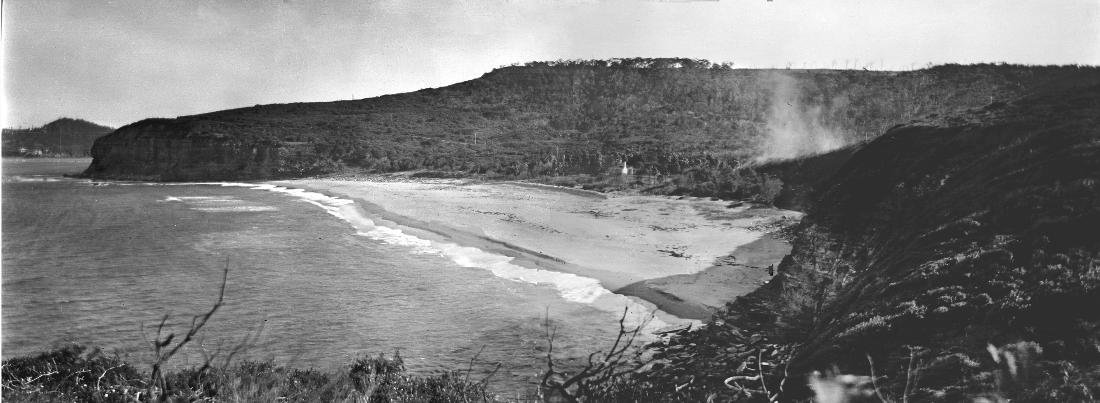
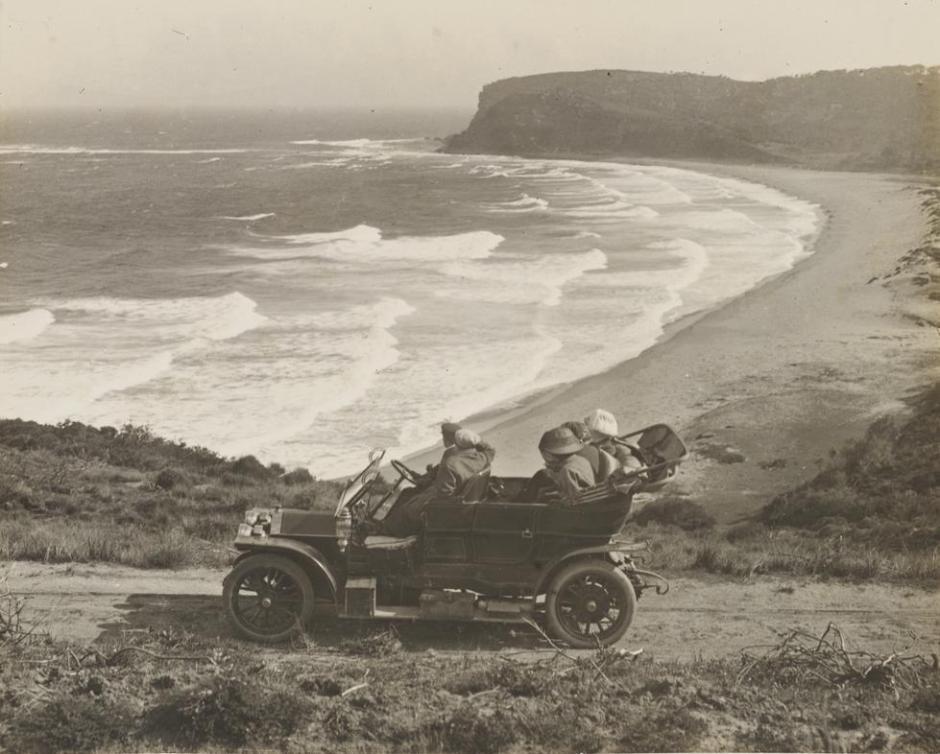
'The Beach just beyond Newport' (this is in fact Newport Beach - then known as 'Farrells Beach') - November 21st, 1909 - from Allen Family Albums: Album 52: Photographs of the Allen family, November - December, 1909 Image No.: a1373015h courtesy State Library of NSW
Bilgola is stated by some to be named after an Aboriginal word meaning “swirling waters” and seems to have been a popular fishing spot for our original custodians prior to the arrival of settlers. First mapped by Government Surveyor James Meehan, the word ‘Belgoula’ was noted in his records of 1814. This ‘swirling waters’name seems very appropriate when you cast your eyes over the long list of people who have drowned in the undertows and rips off this beach prior to the formation of a Surf Club in 1949. Although the western bends protect the plants the northern face is exposed to southerlies and has borne the brunt of many summer storms. During the weekend of 8th - 9th of June 1974 gale force winds devastated a house along the Serpentine and the beach itself as well as other structures from Patonga to Manly. (See file below).
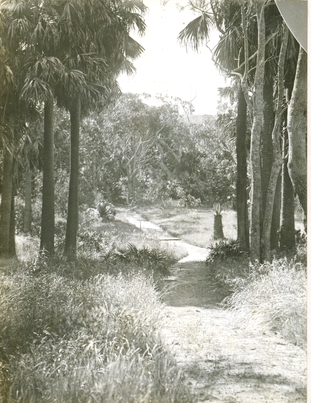
The beach itself, after being named 'Belgoula' was then named 'Dalley's beach' after William Bede Dalley (1831 – 1888) one time Attorney General and Acting Premier of New South Wales who had a beach house in the 1870’s named Bilgola House. The beach is 500m long, faces south east and is bordered by a high headland, Bilgola Head to the north and the lower, shale predominated, Newport Head and rocks to the south. The beach has a single sand bar cut by two shifting beach rips and permanent rips against the rocks at each end. The southern rip is called the ‘Newport Express’ as it flows fast over the rocks and carries the unwary south to Newport. It is also one of the quieter amphitheatres of sand and water in Pittwater and this stillness, due to Bilgola’s form, causes sea mists to linger during season overlaps and create, with moonlit and still water, the stuff of visions. Many artists, writers and actors have resided within its natural enclave.
Left: A path through the Bilgola House grounds in 1913. Pic No: a3292011h from Allen Family Album of same year, courtesy State Library of NSW.
The landscape was once a deep tidal cove, which still shows in the ‘bends’ which curve around the walls of a 400m wide valley. The green reserve surrounding the Bilgola Bends western and northern slopes is known as Hewitt Park. A sandstone escarpment in the uppermost section of the Reserve drops over 75 metres as a very steep slope. A reserve at the south end of the beach, with a constructed track which winds around the headland through to Newport beach has been named Hamilton Reserve. Attunga Reserve, at 7.95 hectares is located over the ridgeline which separates Bilgola and Newport beaches. At the north end of the beach the A (Arthur) J Small Lookout, with a panoramic view south and north, is bounded by thick coastal scrubland. There are two rainfall influenced intermittent creeks, both boulder lined, which drain from Bilgola plateau, one at mid slope and one at the northern end. The northern creek can become a waterfall as it enters this Reserve.
.jpg?timestamp=1537475492208)
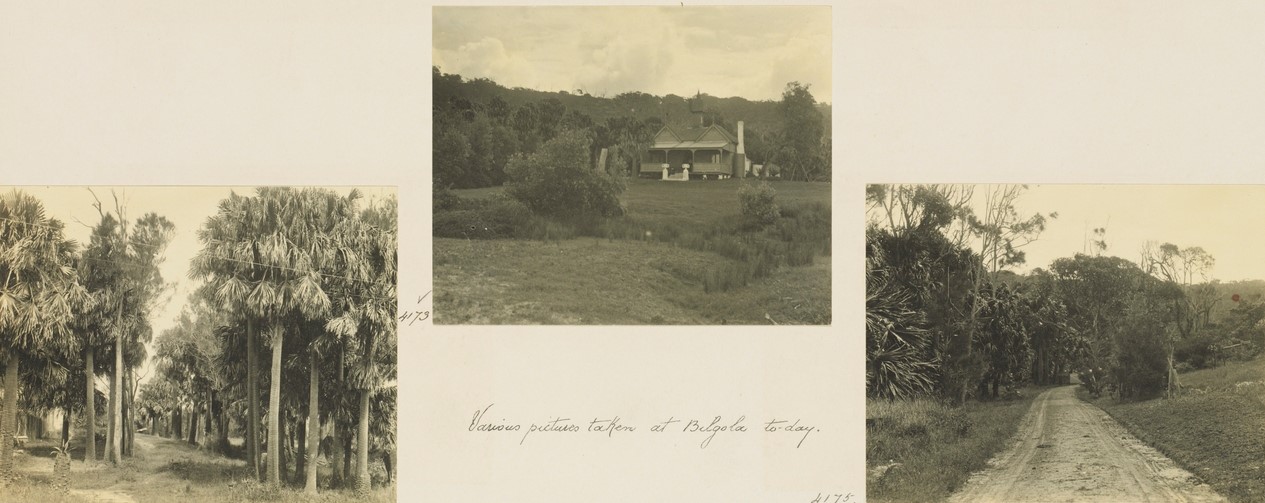


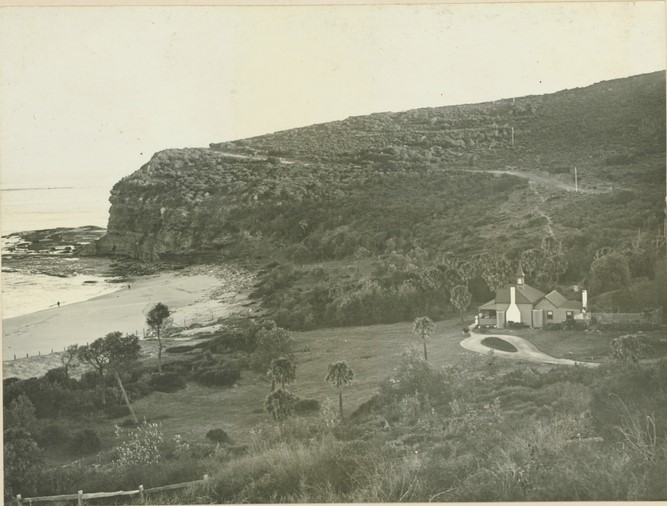
The gully structure of Bilgola has preserved some areas close to their original state and supports a Cabbage-tree Palm Forest (Livistona australis), Lilly Pilly (Acmena smithii) and Guioa (Guioa semiglauca) with emergent eucalypts such as Broad-leaved White Mahogany (E. umbra). An understorey plant world of low tree and shrub layer species include Forest Oak (Allocasuarina torulosa), Veiny Wilkiea (Wilkiea huegeliana), Bolwarra (Eupomatia laurina), Bastard Rosewood (Synoum glandulosum), Mock Olive (Notelaea longifolia) and Sweet Pittosporum (Pittosporum undulatum). The ground layer is dominated by ferns. Common ground layer plants include Rasp Fern (Doodia aspera), Jasmine Morinda (Morinda jasminoides), Settler's Flax (Gymnostachys anceps), Native Grape (Cissus hypoglauca), False Bracken Fern (Calochaena dubia), Lawyer Vine and Harsh Ground-fern (Hypolepis muelleri). Also present are small areas of forest or woodland community where the trees are of lower height than the forest on the upper slopes. Here Smooth-barked Apple (Angophora costata), Rough-barked Apple (Angophora floribunda) and Black She-oak (Allocasuarina littoralis) grow. Associated small tree species include Bangalay (E. botryoides), Cheese Tree (Glochidion ferdinandi), Coast Banksia (Banksia integrifolia) and Blueberry Ash (Elaeocarpus reticulatus).
The fruits of the trees are favoured by species such as the Topknot Pidgeon and seasonal migrants such as the Koel and Channel-billed Cuckoo. Up until 2000 a few koalas had been spotted still living along Bilgola Bends. Predator foxes have been seen at the edge of the road at dusk. The ridgeline, and open scrubland of Attunga reserve, lends itself to raptors both daylight loving, hawks, eagles, peregrine flacons and nocturnal owls. All have been spotted in this area recently and in past years. Birdline NSW reports of white-tailed Tropicbird off the headland in May and Eastern Koel on the top of the ridge in August of this year show this provides a haven for many land and coastal birds in their due seasons.
As a holiday destination is has gone from being a tucked away idyll to a still tucked away with people who live here for its beauty quite prepared to stand up and be counted when it was needed. When interviewing Tom Gilbert for his Profile he spoke of remembering as a child when the Bilgola valley was used as a bit of a dumping ground for building refuse, spoiling what had been a pristine landscape and even the natural lay of the land itself.
Tom's sentiment was echoed by adults in other schemes prior to his time and more recent protests when residents attempted to save the historic Bilgola House and its famed and beautiful gardens.
NARRABEEN LAKES. Protest Against Shell-dredging Scheme.
The Parks and Playgrounds Movement decided yesterday to co-operate with other public bodies in a deputation to the Minister for Local Government to protest against the granting of a lease by the Mines Department to a public company for the dredging of Narrabeen Lakes. Mr. A. J. Small (chairman) said that the company proposed to obtain shells for lime-stone. The dredging of the lakes for this purpose would be detrimental to the surroundings. At present the water in the lakes was shallow and safe for children and non-swimmers, but if the dredging was allowed a dangerous channel, 20 feet deep, would be created down the centre of the main lake. The waters would be stirred up, big holes would be created, and the beauty of Narrabeen Lakes would be spoilt.
The meeting also decided to protest against the action of the Main Roads Department in establishing a quarry on the hillside of Bilgoela Beach. The road from Sydney to Palm Beach, it was stated, was the most beautiful coast drive in the State, and the establishment of the quarry at Bilgoela ruined a delightful vista. The whole of the hillside over-looking the beach was being devastated.
The Main Roads Department, it was stated, was usually very helpful in preserving natural surroundings, but on this occasion no thought or consideration had been given to the question of town planning. NARRABEEN LAKES. (1934, December 6). The Sydney Morning Herald (NSW : 1842 - 1954), p. 15. Retrieved from http://nla.gov.au/nla.news-article28021345
We would like to open this page with a wonderful overview of Bilgola's history in European hands by current secretary of the Bilgola Preservation Society, Anne Spencer and one of our favourite historians Tony Dawson. We referred to this essay when researching some of our own earlier Bilgola Histories and have been given permission by Anne and Tony to run it in full for this celebration of the Bilgola 'garden'.
The Bilgola Preservation Society, was instrumental in the formation of Friends of Bilgola when the historic Bilgola House was demolished over the Christmas of 1989 as it moved from a temporary heritage listing to a more permanent one.
Anne was instrumental in forming the Barrenjoey Montessori Kindergarten and procuring the current premises for it with a peppercorn rent from the NSW Dept of Education at Barrenjoey high school grounds. Anne also initiated the teaching of Indonesian Language in the parent run programme at Bilgola Plateau Public School; fought the installation of mobile phone towers at the school; and was involved in the greening of the wildlife corridor that runs through Barrenjoey High school.
Anne and Colin Spencer, husband, have fought tirelessly over the years to protect the beauty of Bilgola Beach. Colin was also Chair of one of the Committees trying to save Mona Vale Hospital for 6 years.
Mr. Spencer kindly provided a little on the Friends of Bilgola for this record:
When the historic Bilgola House was demolished in 1989 the Friends of Bilgola held several large meetings of community members who were incensed at the demolition Bilgola House, together with all the outbuildings, despite having been listed under Warringah Council’s draft provisions for the control of heritage buildings. The “Friends” shared a common interest in wanting to preserve the beauty and unique qualities of Bilgola Beach which of course was part of Warringah (Pittwater hadn’t seceded at that time).
The Bilgola Preservation Society developed this small group of local residents.
The intention of the then owner to erect townhouses galvanised community feeling and the Bilgola Preservation Society was formed with the aim of protecting Bilgola Beach from unacceptable development. Those early days saw regular meetings at the Bilgola Surf Club with an elected executive and various committees.
The principle stated objective of the Society was,
“To preserve the natural beauty of the area by promoting proper planning of all future development”
As such it set about lobbying Warringah Shire Council for formal planning controls that would achieve the objectives and this it achieved, with the co-operation of the Council, resulting in the formation of the Bilgola Development Control Plan which set development controls for the Bilgola Beach and Bilgola Plateau area.
Pittwater Council was proclaimed in May 1992 and at the early Council meetings from October 1992 the Bilgola Development Control Plan, which resulted from the hard work of the Bilgola Preservation Society, was described by the first Council as a “model code” for Pittwater from which current development codes have their origins.
The Bilgola Preservation Society has been very active over the years in trying to maintain its stated objective with issues such as:
Limiting development on The Hamilton Estate and The Wentworth Estate, Foreshore Protection by generating a setback line from the cliff , Bilgola Beach Plan of Management, Pittwater 21 Development Control Plans, Pittwater Local Environment Plan, Heritage Protection, Iconic Streetscapes for Bilgola Beach, Formalistaion of Bilgola Beach and Bilgola Plateau as individual suburbs, as well as smaller issues like trying to stop the meshing of the headland etc.
BILGOLA - THE STORY OF A POLITICIAN, A PILOT AND AN EPICURE
by Tony Dawson and Anne Spencer
‘Entering the front gates, one passes a large grove of magnificent cabbage-tree palms bordering the drive to the cottage, which stands in a sun-bathed clearing amidst a paradise of leaf and bloom.. On one side of the cottage there are grassy lawns and on the other side there is the continuation of the palm grove, through which runs a small stream; and fully two-thirds of the property are covered with palm trees, burrawongs, wattles, gums and other native trees, the ground being carpeted with maiden-hair and besprinkled with wild violets and other native flowers.’
This description of Bilgola was penned by John Sydney Richardson almost ninety years ago. Yet Bilgola continues to occupy a special place not only in the history of the Peninsula but of the nation, for three of the early owners, each a pioneer in his or her own field, made indelible marks on Australian life and culture.
William Bede Dalley (1831-1888)
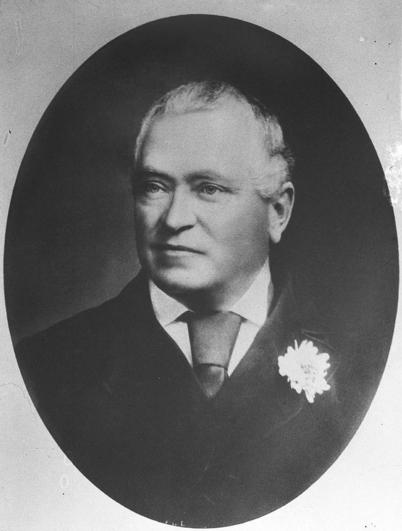 The story of Bilgola House begins with W B Dalley, the celebrated politician and lawyer, when he acquired the title to lots 22 and 23 of the southern division of the Reverend John Joseph Therry’s Pittwater estate, having purchased them from the former owners, Michael Moran and John & Marion Stevenson, for a total of £585-5s-6d. The transfers of ownership officially took place in June and October 1886, though it is likely that the agreements had been reached months—perhaps a year or more—earlier and that Dalley had use of the land well before the formal exchanges were made.
The story of Bilgola House begins with W B Dalley, the celebrated politician and lawyer, when he acquired the title to lots 22 and 23 of the southern division of the Reverend John Joseph Therry’s Pittwater estate, having purchased them from the former owners, Michael Moran and John & Marion Stevenson, for a total of £585-5s-6d. The transfers of ownership officially took place in June and October 1886, though it is likely that the agreements had been reached months—perhaps a year or more—earlier and that Dalley had use of the land well before the formal exchanges were made.
Although lot 22 was generally steep, lot 23, below it, ran gently down to the beach, and it was there that Dalley built a weatherboard cottage. ‘Tallamalla’, as the house was named, offered a retreat from the hurly burly of Macquarie Street and was Dalley’s second house on the Peninsula, the far more opulent ‘Marinella’, better known as ‘Dalley’s Castle,’ at Manly having been built some years earlier. But ‘Tallamalla’ occupied a particularly idyllic spot with a small creek, lined with palms and ferns, running along its southern boundary and with lawns stretching towards the beach.
Long before he took up the land at Bilgola, Dalley had become one of the colony’s leading figures. The son of storekeeper John Dalley and Catherine Spillane, both former convicts, he was educated at St Mary’s seminary and the Sydney College. After qualifying as a barrister in 1856 he was nominated by Henry Parkes for the seat of Sydney and took his place in the NSW parliament. In the 1858 election he moved to the seat of Cumberland Boroughs and afterwards served two years as solicitor-general before resigning in order to visit the UK and Europe. He returned to Sydney in 1861 but almost immediately he and Parkes went back to London as immigration commissioners, returning again to Sydney some eighteen months later.
Dalley was a flamboyant character and persuasive orator. In Court he used his charm to advantage, though even his famed advocacy was unable to prevent the conviction of bushranger Frank Gardiner in 1864 or save Henry O’Farrell from the gallows after the attempted assassination of the Duke of Edinburgh at Clontarf in 1868. Later, however, he strongly supported the release of Gardiner from prison, a decision that contributed to the fall of the Parkes government in 1875. By that time, Dalley’s relationship with Parkes, his former friend, was strained but he went on to serve as attorney general in the subsequent administrations of both Sir John Robertson and Parkes himself. The three men—Robertson, Parkes and Dalley—were later amusingly commemorated when their heads were carved on two ornate flower urns which took pride of place in the gardens at Bilgola.
Dalley retired from the Legislative Council in April 1880 after ten years of broken service. He cited family reasons for his decision as he and his wife Eleanor (nee Long) had six children from their eight-year marriage. However, in January 1881 Eleanor contracted typhoid fever and died at their home in Rose Bay. Dalley afterwards retreated from public life in order to devote himself to his children.
He was not, however, the kind of person to stay out of the political fray too long. In 1882 he purchased the land at Manly on which he built ‘Marinella’, and in 1883 he again took a seat in the Legislative Council, accepting re-appointment to his old position of attorney-general. Later that year he participated in the Intercolonial Convention, and in February 1885, as Acting Premier during Sir Alexander Stuart’s illness, he stunned the nation by offering a NSW contingent to help Britain in the Sudan campaign, an offer which led to the first overseas expedition by an Australian military force.
In 1886, shortly after purchasing the land at Bilgola, Dalley was informed that Queen Victoria had consented to his swearing in as Australia’s first privy councillor. However, as time wore on, his parliamentary duties and differences with other politicians, including Parkes, over questions such as German capital investment and Chinese immigration took a toll on his health, and in January 1888 Dalley put up both ‘Tallamalla’ and ‘Marinella’ for auction.
The auctioneers, Mills & Pile, described ‘Tallamalla’ as occupying the ‘pick of spots along the northern coast’ and being the ‘most charming marine villa site in the colony.’ There were two residences, ‘one for the caretaker, and the other for the owner's use’. There was also ‘a large frontage to Bilgola Bay, with the best fishing grounds the most enthusiastic disciple of Isaac Walton could desire’2 and although Dalley’s tenure at Bilgola had been relatively short, the beach was known as Dalley’s Beach for many years afterwards.
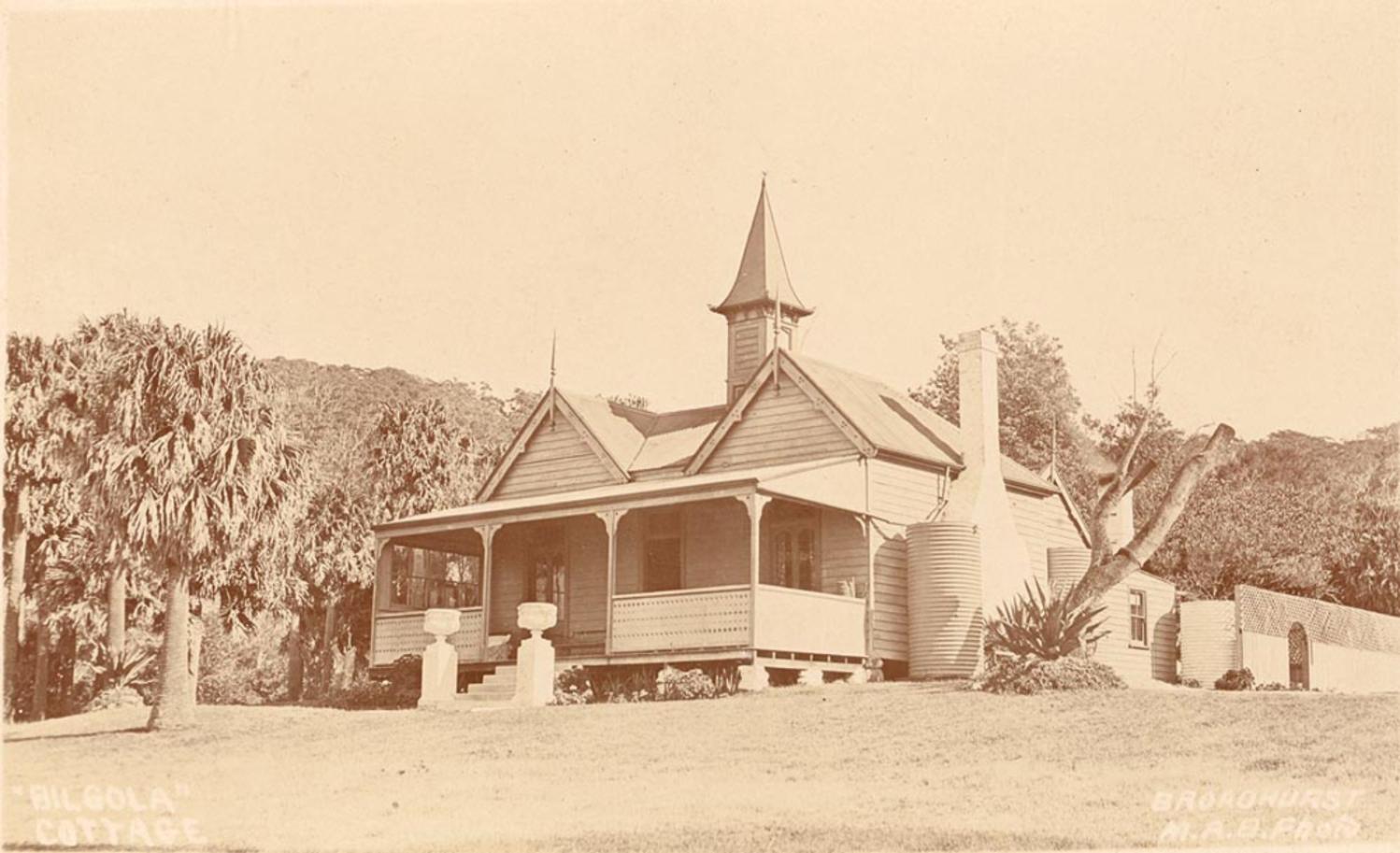
Dalley’s weatherboard cottage ‘Tallamalla’, courtesy State Library of NSW Image No.: a105043h ca. 1900-1927 from Album: Sydney & Ashfield : Broadhurst Post Card Publishers
Both properties were purchased by Melbourne merchants Malcolm Donald McEacham and John McIlwraith, and they were still in possession when, on 28 October 1888, William Bede Dalley died at his house on Darling Point.
His funeral took place two days later and was attended by an immense number of people including the governor’s representative, members of both Houses of Parliament, members of the Bar, public officials, representatives of municipal bodies, and many ordinary citizens, Following a two-hour-long requiem high mass at St Mary’s Cathedral, the cortege, comprising around 150 vehicles, proceeded to Waverley Cemetery for the burial, while thousands of people lined the route to pay their last respects to one of the nation’s best-loved men.
_______________________________________
After Dalley’s death, the new owners of ‘Tallamalla’ made little, if any, use of the house and within a year both it and ‘Marinella’ were again put up for auction. No buyer was found but in 1892, by an order of the bankruptcy court, ‘Tallamalla’ was sold. The purchaser was William John McGaw, the owner of Kooba Station, a large grazing property in the Riverina. He and his wife, Sarah Maria, who were great benefactors to the Presbyterian Church, also purchased ‘Marinella’, which was renamed ‘The Towers’ and, later, ‘The Castle’. After her husband’s death in 1894, Mrs McGaw continued to live there until she, too, died in 1922. Meanwhile, their application to bring the property at Bilgola under the provisions of the Real Property Act 1863 was approved, and on 15 December 1897 Mrs McGaw, by then widowed, was issued with the new Certificate of Title embracing the entire 18 acres.
Mrs McGaw held on to the land until May 1909 when she sold it to Henry Zeddon Jones of Manly. Three years later, on 3 May 1912, Jones sold the smaller portion, on which ‘Tallamalla’ stood, to Oswald Watt, the second prominent Australian with whom this essay is concerned.
________________________________________
Walter Oswald Watt (1878-1921)
Oswald Watt was born in Bournemouth during a family visit to England. His father, John Brown Watt, had come to Sydney in 1842 as a 16-year-old to join his uncle’s mercantile and shipping firm. He had soon proved his worth and by 1861 was a prominent businessman in his own right with a seat in the NSW Legislative Council where, for many years, he served alongside W B Dalley with whom he developed a close friendship. In 1862 he married Mary Jane Holden and over the next sixteen years they had six children of whom Oswald was the youngest. The Watts returned to Sydney in 1879 but Mary Jane died that same year leaving John Watt with the responsibility for the children’s upbringing.
Oswald spent his early years at ‘Eynesbury’, their house in Edgecliff in Sydney’s eastern suburbs, but in 1888 his father again decided to take the family to England in order to find a suitable school for Oswald and his elder brother Ernest. While there, John Watt was overcome by illness and although he survived until 1897 he was never able to return to Australia. Oswald, however, completed school and went on to Cambridge University, graduating in Natural Science in 1899, two years after his father’s death. Later that year he sailed back to Sydney where he accepted a commission as second lieutenant in the NSW Scottish Rifles and acted as aide-de-camp to two NSW governors, Sir Harry Rawson and Sir Frederick Darley. At the same time, he took a great interest in pastoral matters, purchasing Howlong station at Carrathool and having stakes in Llanillo, Goonal and Gunningrah stations in NSW, as well as two Queensland cattlestations, Strathmore at Bowen and Glen Prairie at Rockhampton.
In 1902 Oswald married Muriel Maud Williams, daughter of the prominent Melbourne judge, Sir Hartley Williams. After their marriage the couple lived initially at Camden, then at Woollahra, and had one son, born in 1905. In 1909 during an extended visit to England, Oswald decided to return to Australia alone, ostensibly on business. When he arrived back in London in May 1910, he seemed to have changed, paying little attention to his wife. Watt excused himself by claiming illness but their relationship continued to deteriorate despite one or two attempts at reconciliation.
By then Oswald had become fascinated by flying, a pursuit very much in its infancy, and he decided to undergo training at Salisbury Plain. In 1911 he was awarded his Aviators Certificate by the Royal Aero Club and became the first Australian to become a fully qualified pilot. On his return to Sydney, unaccompanied by his wife, he began making visits to Bilgola, then owned by Henry Zeddon Jones. One of members of the party that accompanied him from time to time was Ivy Schilling, a dancer with the J. C. Williamson company and a popular ‘beach beauty’. She had earlier been dubbed a heroine after saving the well-known surfer Tommy Walker when he supposedly got into difficulties in the water at South Steyne. The rescue could have been genuine but had the smell of a publicity stunt, celebrity culture being as alive then as it is today.
Watt must have enjoyed his weekends at Bilgola for on 3 May 1912 he purchased the land and seaside villa from Jones and spent as much time as he could there, entertaining friends and making improvements to the property. He had already indicated to Muriel that he had no interest in continuing their marriage so in 1913 she petitioned for divorce on the grounds of adultery, naming Ivy Schilling as co-respondent. The case was heard before Mr. Justice Gordon and neither Oswald nor Ivy contested the evidence. Accordingly, the decree nisi was granted in September 1913 and the divorce finalised in April 1914, with sole custody of their son awarded to Muriel.
Watt had not attended court during the divorce proceedings and by late 1913 he was already in France where he purchased a Bleriot XI monoplane which he afterwards flew in Egypt. He was in Paris when war broke out and he immediately offered both his plane and his services to France, joining the Aviation Militaire branch of the French Foreign Legion. He was posted to a squadron at Toul in eastern France where he flew a Maurice Farman biplane with a white kangaroo and the words ‘Advance Australia’ painted on its nose. His aerial exploits earned him the Legion d’honneur and the Croix de Guerre, the first of these being awarded after he and his observer were forced to land midway between the French and German lines. They had come under heavy fire from the enemy's trenches but reached the French lines safely, bringing back valuable information.
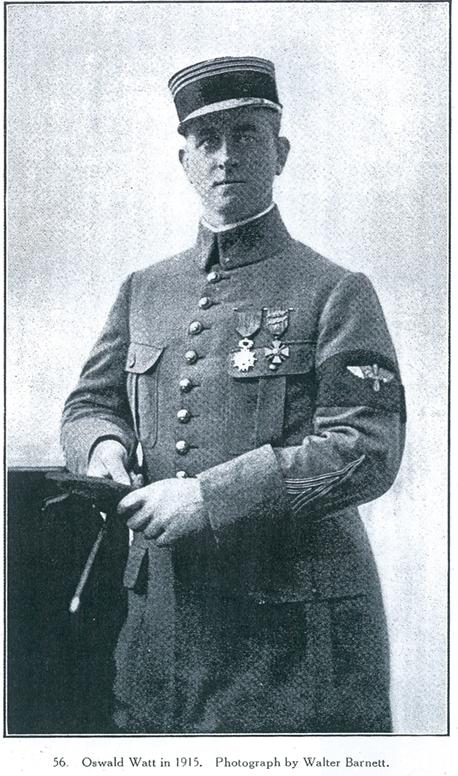
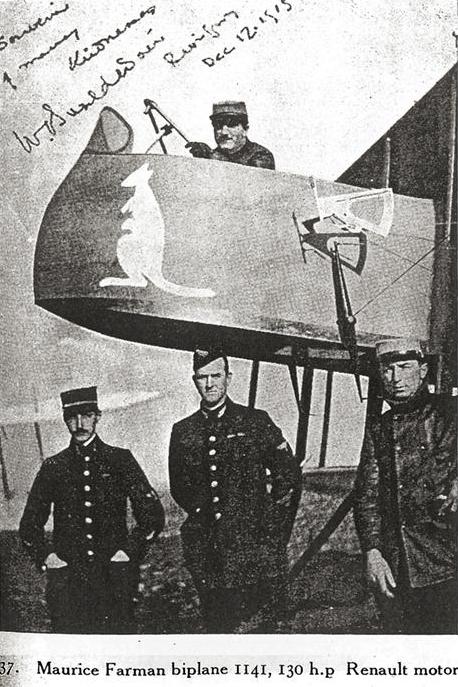
Although Watt enjoyed the titular rank of ‘captain’, he was not a French citizen and his formal rank was that of a simple infantryman. This meant that he could not be given a command so in 1916 he transferred to the newly formed Australian Flying Corps where he was officially made captain and given command of 8 Flight, No. 1 Squadron, then stationed in Egypt.
Soon afterwards he was promoted to major and took command of No. 2 Squadron which, after a period of training in England, was despatched to the Western Front where they distinguished themselves, thanks largely to Watt whose generosity and loyalty to his men inspired their feats. Later, Watt, now lieutenant-colonel, assumed command of four squadrons of the Australian Training Wing at Tetbury. Again, he inspired his crews with ideals of service and they, in turn, were proud to serve under such a distinguished leader.
Watt returned to Australia in 1919 and was unstinting in his efforts to help his former AFC colleagues. He maintained a strong interest in aviation, becoming the foundation president of the NSW section of the Australian Aero Club, and was also busy as a partner in Gilchrist, Watts & Sanderson, the family company, and as a director of several other companies. However, he spent as much time as he could at Bilgola and was said to be at his happiest there, working in the garden, digging and planting, and entertaining his friends. His guests did the cooking and on many a weekend the quiet air of Bilgola would ring with laughter, though not drunken revelry as Watt did not allow alcohol at his parties.
Early on the morning of 21 May 1921 Oswald Watt went to the beach alone, taking his towel and wearing his swimming costume under his bathrobe. He is thought to have been gathering firewood before taking his morning dip. Some time later his caretaker, Sydney Jones, saw his body floating in the water and rushed to Newport for help. Some fishermen went round the headland by boat and recovered him. Mr Bulfin, a local resident, and Constable Grant from Mona Vale tried to resuscitate Watt but their efforts failed and Dr Richards afterwards pronounced him dead. On examination he was found to have a bruise on the back of the head and a cut on the forehead, as well as scratches on one cheek. It appeared that Watt had slipped and was rendered unconscious when his head struck the rocks, causing him to drown in comparatively shallow water. The news of his death was devastating to his friends. A. Consett Stephen wrote of his shock – it was ‘as though some bright bird of gorgeous plumage, which I had been watching in full flight, had suddenly dropped stricken at my feet.’
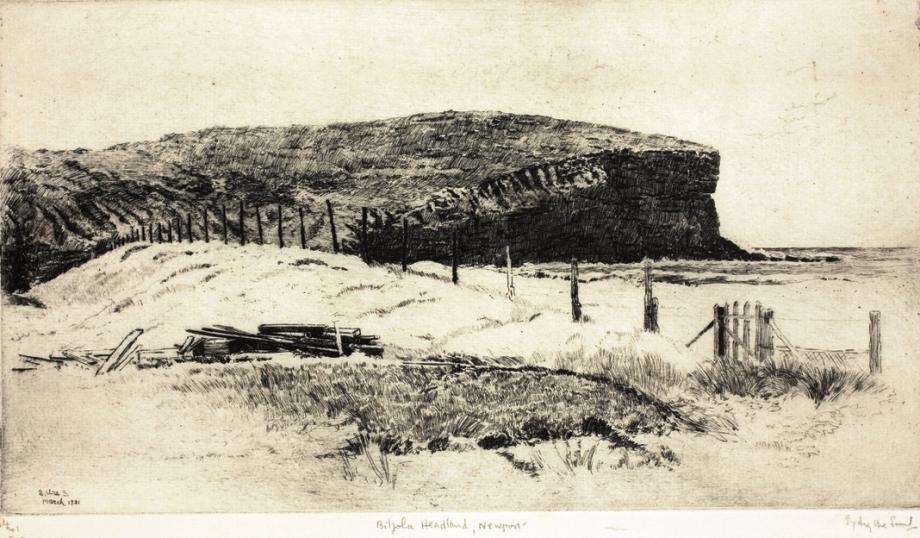
On base of sketch "It was here that Colonel Oswald Watt met his death. Drawn from Col. Watt's seaside residence 'Bilgola' when I was staying a weekend with him - a few months prior to his death." Sydney Ure Smith - March 1921 - Image No.: a7065001h courtesy State Library of NSW - and Below - one from Anne's records:
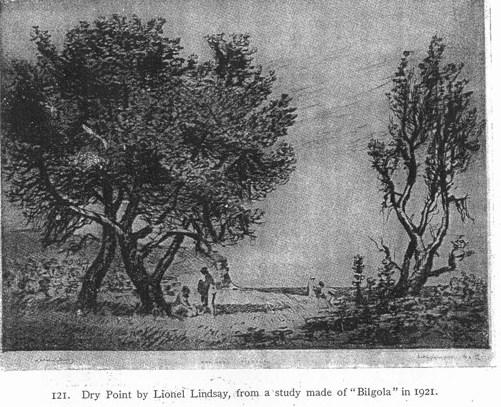
Oswald Watt was sadly grieved by all who knew him and he was buried at St. Jude’s churchyard in Randwick with full military honours. Only afterwards, when his will was opened, was it discovered that he had wanted to be cremated. His wishes were observed but because cremation was not yet legal in NSW the body was sent to South Australia and the ashes returned afterwards for reburial at St Jude’s, an unusual finale to an unorthodox life.
_____________________________________
For probate purposes Watt’s estate was valued at £176,845, and prior to his death he appointed the Perpetual Trustee Company Ltd as his executors and trustees. His will provided generously for his relatives, including his 15-year-old son, then at school in England, as well as many of his friends. A bequest of £500 was also made to the Australian Aero Club ‘for the purchase of a gold medal, to be presented each year to the aviator who, in the opinion of the council, achieves the most brilliant feat in the air in the Commonwealth, or to the Australian-born aviator performing the most brilliant feat outside the Commonwealth.’ The Oswald Watt Gold Medal for 1921, the first to be awarded, was presented retrospectively in 1927 to F. S. Briggs for a flight from Melbourne to Brisbane and one from Melbourne to Perth. Recipients since then have included aviation luminaries such as Charles Kingsford Smith, Bert Hinkler, and, more recently, Dick Smith, the medal now being awarded under the auspices of the Royal Federation of Aero Clubs of Australia.
As to the property at Bilgola, it was soon sold to Harry James Brigden, a public accountant who subdivided it into twenty eight lots that were offered for sale in February 1922. Among the buyers were Hannah Maclurcan and Robert Lee who, as tenants in common, purchased almost half the lots in the estate. They were later married, but it is in Hannah Maclurcan, the hotelier who achieved fame for her Australian equivalent to Isabella Beeton’s ‘Book of Household Management’ (better known as ‘Mrs Beeton’s Cookbook’), that our interest lies.
______________________________________
Hannah Maclurcan (1860-1936)
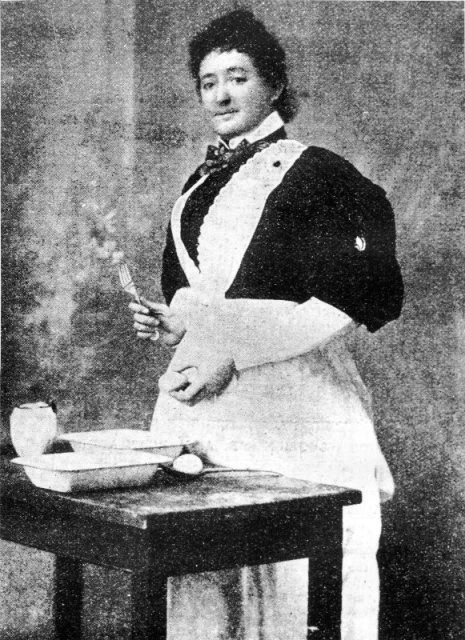 On 17 October 1860, at Tambaroora near Hill End in NSW, Susan Phillips, wife of Jacob Aaron Phillips, gave birth to her fourth child, Hannah. By 1866 the family had moved to Queensland where Jacob Phillips took up the licence to a hotel in Townsville and, at an early age, Hannah began work in the kitchen. She later worked in the dining room, then in the hotel office, and learned the ropes so well that when she was about fifteen her father sent her to manage his Club Hotel at Toowoomba.
On 17 October 1860, at Tambaroora near Hill End in NSW, Susan Phillips, wife of Jacob Aaron Phillips, gave birth to her fourth child, Hannah. By 1866 the family had moved to Queensland where Jacob Phillips took up the licence to a hotel in Townsville and, at an early age, Hannah began work in the kitchen. She later worked in the dining room, then in the hotel office, and learned the ropes so well that when she was about fifteen her father sent her to manage his Club Hotel at Toowoomba.
Hannah Maclurcan 1898, courtesy Townsville City Library
In 1880 Hannah married Robert Watson Wigham, an English-born banker, and had two daughters by him. However, the marriage did not last long, though there is some uncertainty as to whether Hannah was widowed or divorced. Whatever the case, she was still known as Wigham in 1887 when she married Donald Charles Boulton Maclurcan, a retired master mariner whom, over the next two years, she presented with another daughter and a son, Charles Dansie. The Maclurcans ran the Criterion Hotel and later the Queen's Hotel at Townsville, but although Donald was the licensee it was Hannah who managed the business. The breakthrough came in 1898 when Hannah, already a renowned cook, published her book Mrs Maclurcan's Cookery Book: A Collection of Practical Recipes, Specially Suitable for Australia.
The book contained recipes for such delicacies as kangaroo tail soup, pawpaw pie, fried choko, roast wallaby, Galantine de Poulet à l’escarlete (boiled chicken in scarlet jelly), as well as the more usual dishes, and immediately proved popular. The first edition sold out within weeks and the second, which appeared later the same year, had a letter of endorsement from Lady Lamington. There were a further eighteen editions, the last of which was published in 1930.
With her new-found stardom, money earned in the hotel business and from her book, and husband in tow, Hannah moved to Sydney where, in April 1903, she took over the management of the Wentworth Hotel on Church Hill (now Grosvenor Street), near Wynyard Square. Again, as a married woman, she could not hold the lease but it was her money, and money advanced under a bill of sale, that was used to purchase furniture and stock for the hotel. Paradoxically, when Donald Maclurcan died less than three months later, Hannah became eligible to hold the lease but it was not until 1905 that this was acknowledged through a friendly action in the NSW Equity Court.
Hannah Maclurcan transformed the Wentworth Hotel into one of the most fashionable establishments in Australia. She had the occasional brush with the law, as in 1914 when, after the hotel garden was used for a ragtime dance competition, she was charged with permitting dancing on the grounds of a licensed house. She was fined £1 with 6 shillings costs. A larger fine was imposed in 1926 when she was found guilty of selling liquor after hours - this time it was £3. Trivial actions of this kind did her no harm; if anything, they were probably good for business!
Hannah’s staff at the Wentworth referred to her as ‘Madame’ and among her more famous guests were Dame Nellie Melba and the ‘divine’ Sarah Bernhardt. The hotel’s magnificent ballroom was frequently used, and when, in 1920, a young visiting Englishman asked if he might join the dancers there, Hannah graciously obliged, for it was not every day that the Prince of Wales and future King Edward VIII asked such a favour. The prince afterwards returned the compliment by autographing a copy of the menu, a rare royal gesture.
It was not only Hannah, with her exclusive fashions, her Pekinese dogs and her cheap cigarettes in a long, elegant cigarette holder, that became a Sydney celebrity, but also her son, Charles, an amateur radio enthusiast who, in 1910, transmitted the first radio signals from the roof of the hotel. Although fire destroyed the Wentworth installation in 1912 Charles became a pioneer of radio with 2CM, his private station in Strathfield, and in 1924 his transmissions were the among the first to cross the Pacific and be heard in USA.
The 1920s were the hey-day of the Wentworth and Hannah, conscious of her social responsibilities, often organised fundraising events for a variety of charitable causes. She also oversaw the regular production of the Wentworth Magazine with its significant literary content. However, she was then in her sixties and needed a place where she could relax. Bilgola fitted the bill perfectly and Hannah erected a new house there to serve as a retreat and for entertaining her private guests. She spent a very large amount of money on the gardens, and filled the house with curios and antiques acquired during her regular trips to the United States. Members of the Royal Australian Historical Society who visited there in 1926 were impressed with the beauty of the place.
In 1931 Hannah married her partner, Robert Lee, at a ceremony held in Mordialloc, Victoria. The following year, back in Sydney, Lee, a wool broker who two years earlier had been placed under a sequestration order for bankruptcy, was hauled before the Central Summons Court on charges of having intended to defraud the Bank of NSW of over £37,000. He was committed for trial but the evidence was weak and he was acquitted. This undoubtedly came as a relief not only to him but to Hannah who had just retired after transferring the licence for the Wentworth to James Alfred Duncan.
Bilgola, by then, had become Hannah’s permanent home and she spent the rest of her days there in style and comfort, enjoying the company of her dogs, family and friends, amongst whom she could count Dr J J C Bradfield, the designer and engineer-in-charge of the Sydney Harbour Bridge which was opened the same year that Hannah retired.
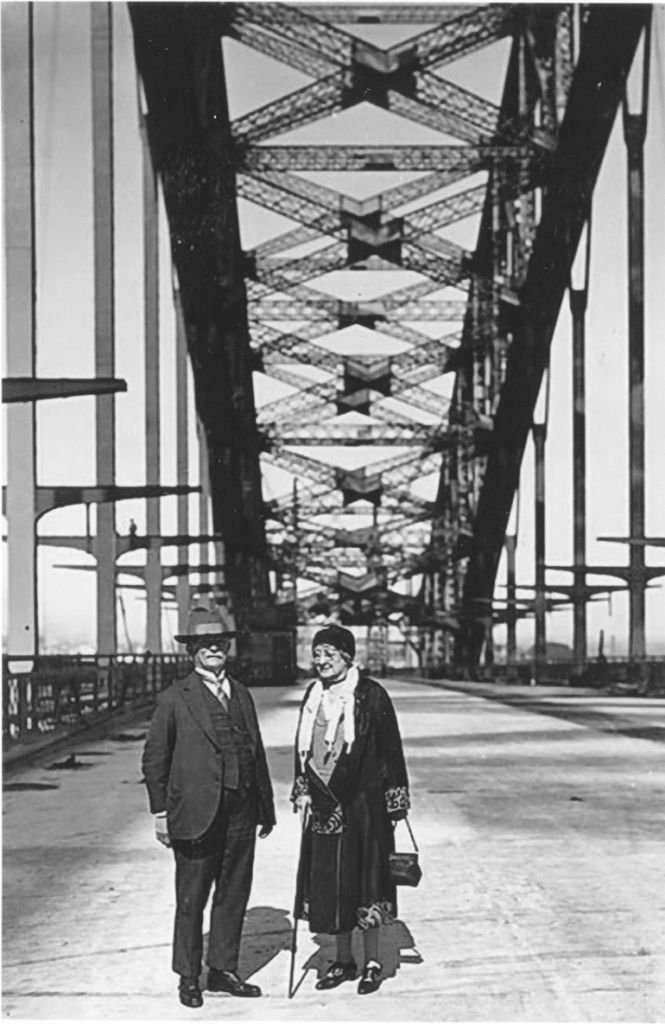
Hannah and Bradfield on Sydney Harbour bridge prior to opening - courtesy Avalon Beach Historical Society
Shortly before her death Hannah was admitted to St Vincent's Private Hospital where she passed away on 27 September 1936. She was privately cremated at the Rookwood Crematorium the next day. Though there were few people present at her funeral, her enduring legacy to the nation was the confidence she had brought to Australian cuisine, something readily acknowledged today.
______________________________________
Hannah Maclurcan’s Bilgola estate passed to Hannah’s son, Charles, and was eventually sold.
However, the house that offered such comfort to W B Dalley, Oswald Watt, Hannah Maclurcan and others is, sadly, no longer with us. It was demolished in 1989, together with all the outbuildings, despite having been listed under Warringah Council’s draft provisions for the control of heritage buildings. The intention of the then owner was to erect townhouses on the site but community protest led to the rejection of this and subsequent plans.
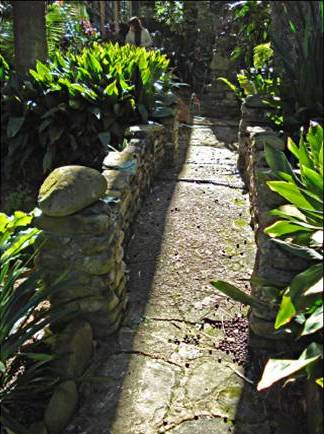
Stone bridge over Bilgola Creek
Today, five houses occupy the site and the present owners have been careful to preserve many of the heritage items – a grove of tall cabbage-tree palms, trees lining the avenue, the old entrance posts, dry stone walls bordering the creek, small bridge structures, lined garden beds, pedestals, wells, and even the flower urns on which the carved heads of Henry Parkes, John Robertson and William Dalley can still be discerned.
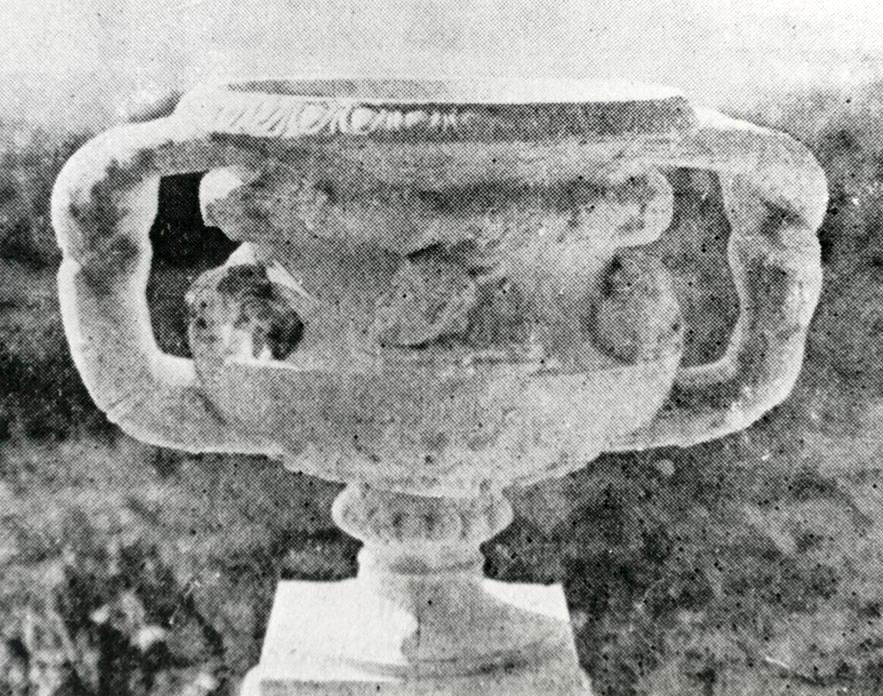
Flower urn revealing one of the carved heads
Principal sources:
Land and Property Management Authority; National Library of Australia Newspaper Digitisation Project; Australian Dictionary of Biography; Registries of Births, Deaths & Marriages – NSW, QLD, VIC; State Library of NSW; State Records NSW; Oswald Watt – a tribute to his memory by a few of his friends (1921); Royal Federation of Australian Aero Clubs; Anne Bishop, Irene Newport - personal communication. For more detailed references please contact the authors.
Reference:
2. Isaac Walton’s book The Compleat Angler, which first appeared in 1653, is reputed to be the third most published book in English literature after the Bible and the Complete Works of Shakespeare.
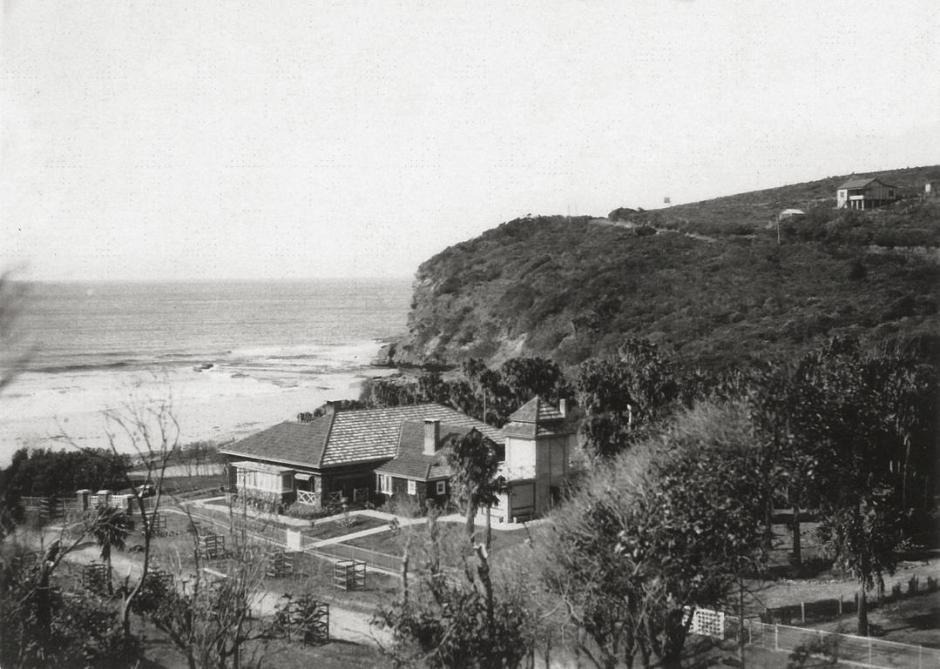
Bilgola House c.1935
Below: Hannah Maclurcan with family c.1935
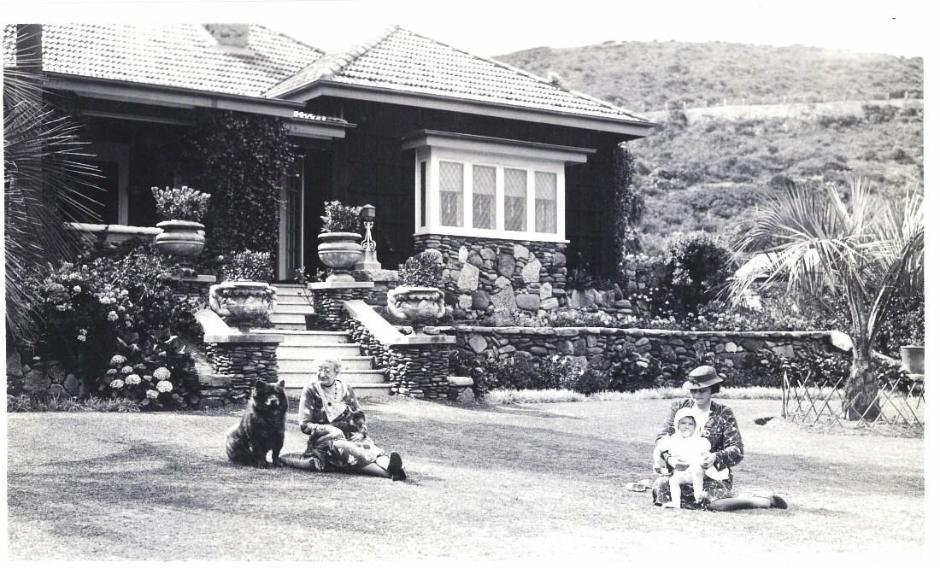
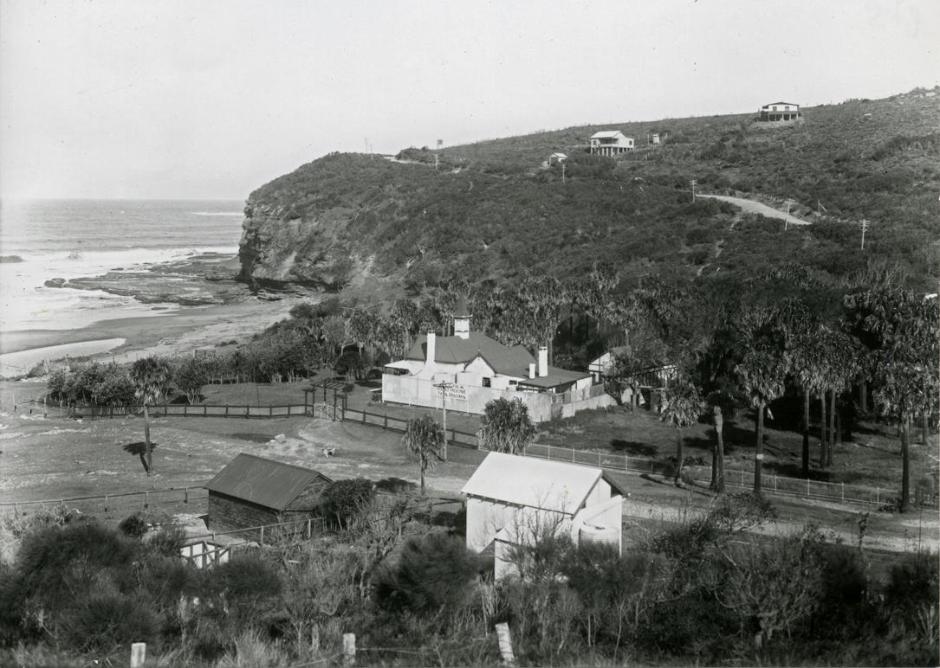
Bilgola House for Afternoon Teas! - circa 1925 - same picture as a State library of NSW GPO picture dated 1925 - picture courtesy Anne Spencer
State Library of NSW records state: Mona Vale views: a corner of Bilgola Level of Description- Series Date of Work 6/1925 Type of Material Graphic Materials Call Number Government Printing Office 1 - 15677
Below: Samuel Wood - postcard photonegatives of Avalon, Bilgola and Newport, ca. 1928 copies of ca. 1928 nitrate photonegatives Images No.: a1470002h and a1470001h
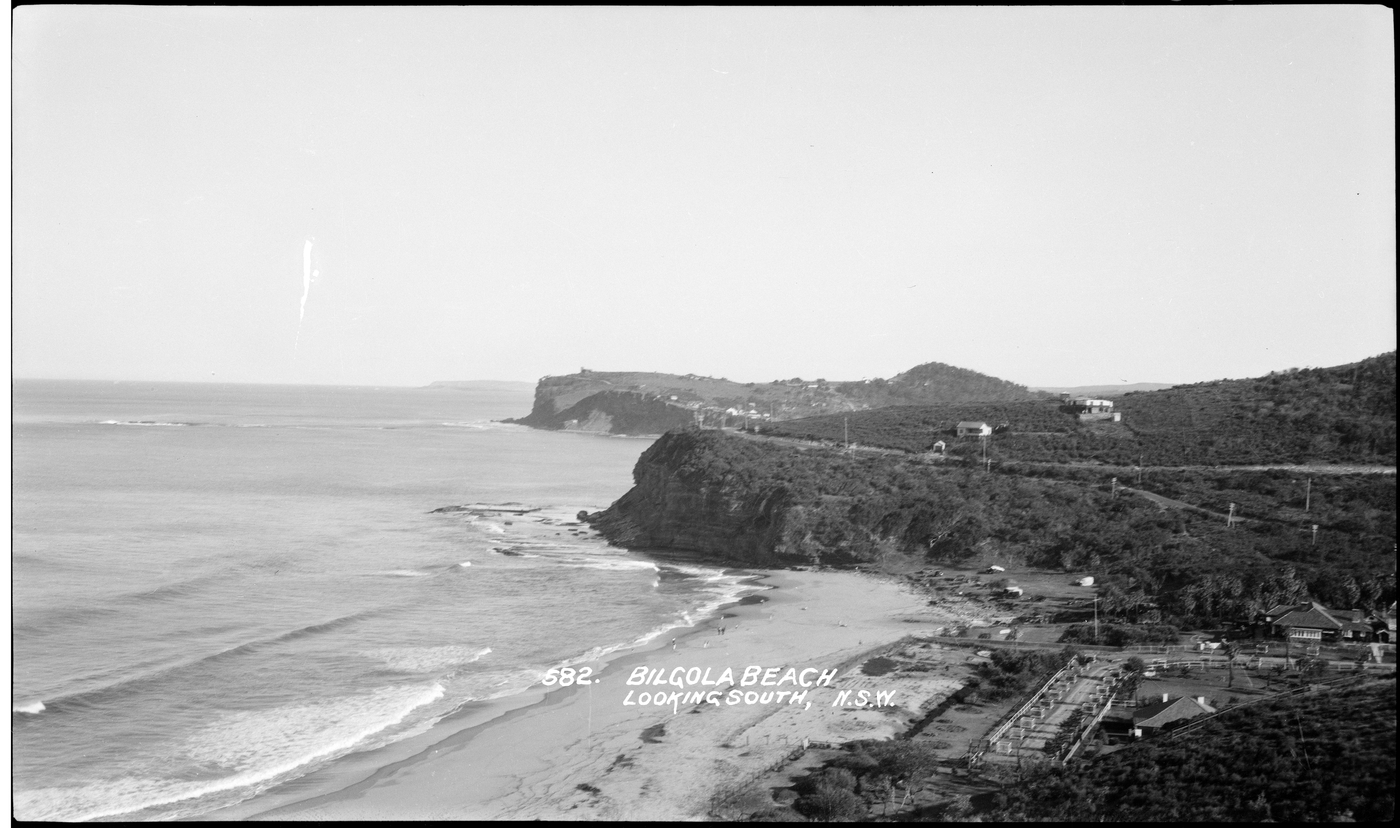
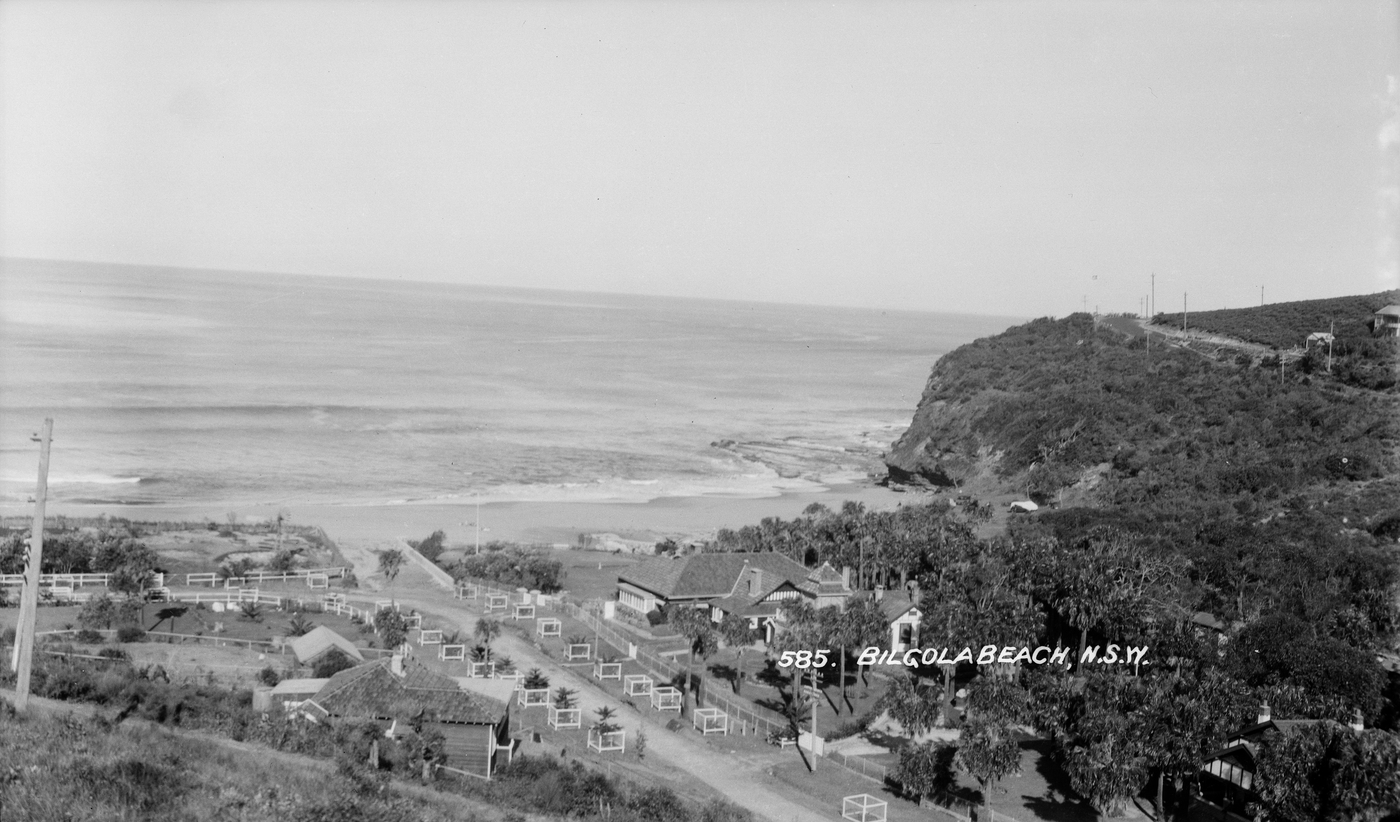
BILGOLA - THE STORY OF A POLITICIAN, A PILOT AND AN EPICURE by Tony Dawson and Anne Spencer, Treasurer of the Bilgola Preservation Society.
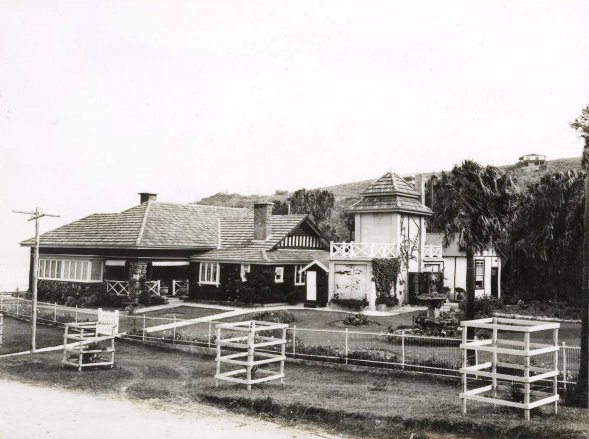
John Maclurcan, great grandson of Hannah Maclurcan, sent us an email in December 2013 regarding his great grandmother:
"Hannah did not work for her father in Townsville when she was 15 (1875). Her father never ran a hotel in Townsville. From 1861 to 1870, he was based in Toowoomba from where he moved to Brisbane. In 1875, he put her to work in his hotel in Sandgate. Hannah did not work in Townsville until 20 years later when she and my great grandfather ran the Criterion Hotel, late to take over the Queen's."
Right: National Library of Australia pic; 24768467. Bilgola House 1928, Samuel Wood
Here is just one of the references which confirm this.
Sunday, 27th November, 1921 – Sunday Times: Mrs. Maclurcan is pictured to-day. She is so well known in Sydney's social and business circles that she scarcely needs an introduction. She started her remarkable business career with her father, and actually managed his hotel at Sandgate when she was 16. Mrs. Maclurcan has a remarkable gift for organisation, as anyone who has been concerned in charity functions at the Wentworth Cafe will testify. The functions arranged under her direction give so little trouble to the executive members that they can enjoy the parties just as heartily as the patrons who have not helped in getting them up. Mrs. Maclurcan goes abroad periodically to glean new ideas for the running of the cafe. She is now directing the enlargement of the beautiful ballroom, and expects it to be in readiness for the Christmas and New Year celebrations.
The Cabbage Tree Gardens and Camping Grounds
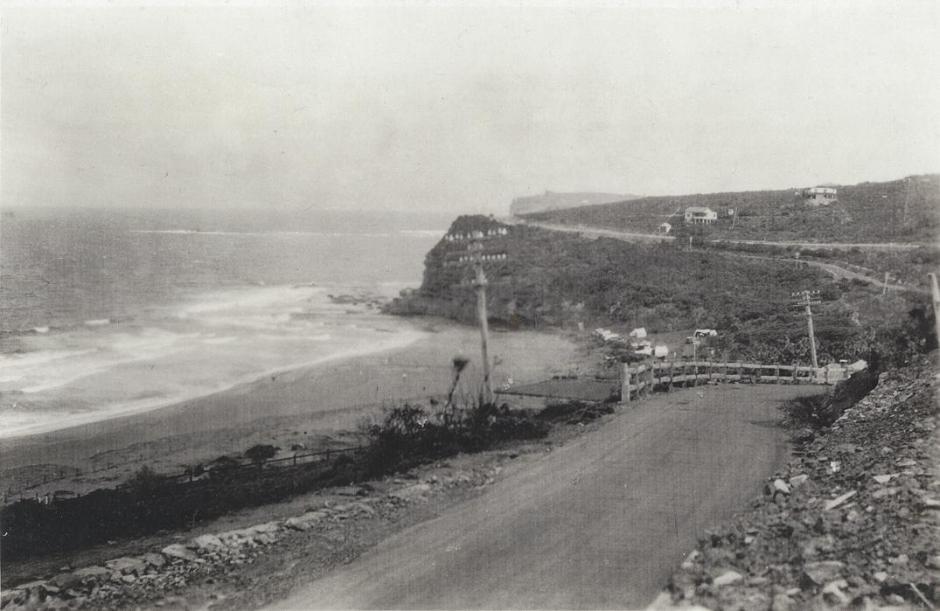
Bilgola - tents may be seen next to beach - picture courtesy Anne Spencer - Below from National Geographic Magazine - December 1935 - courtesy G W Moore and Anne Spencer
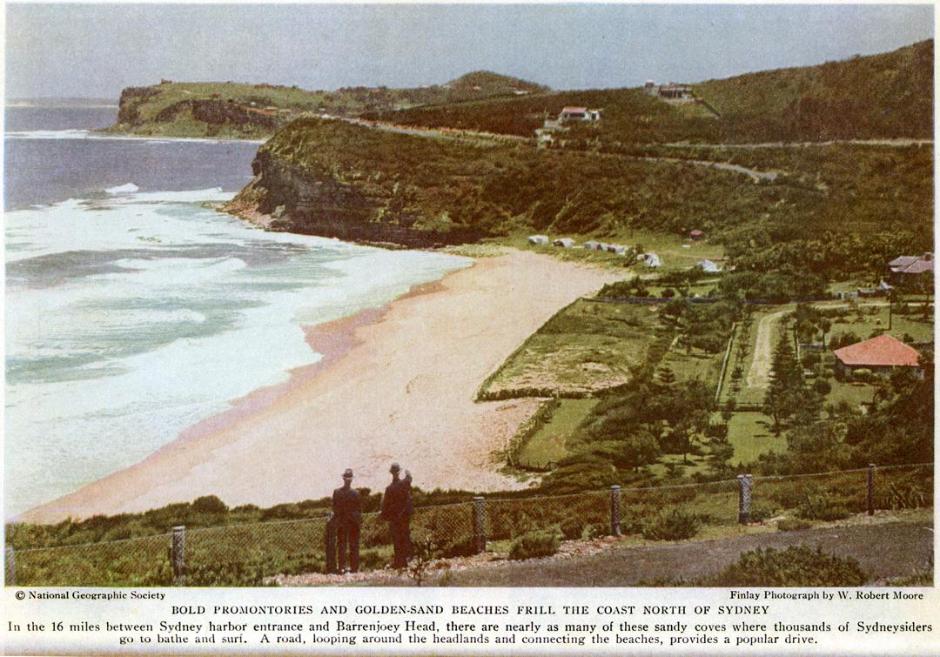
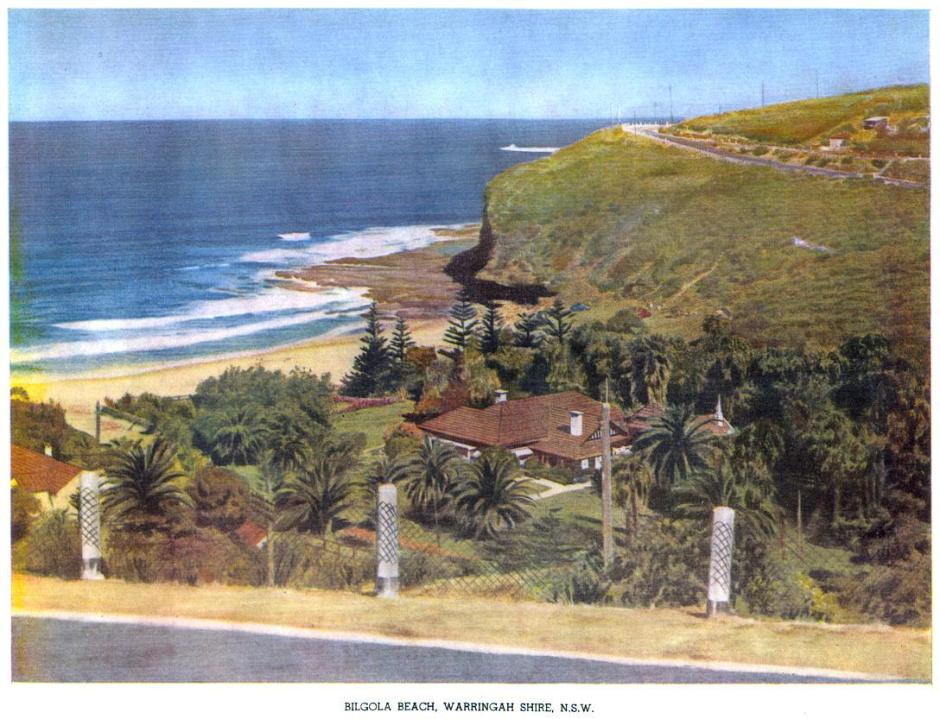
Bilgola, while a popular weekend resort for those mentioned above in Anne and Tony's essay, was also a place that attracted more and more folk as the first decade of the new century elapsed. One of Australia's original surfer girls, Isabel Letham, was stated to be attracted to Bilgola and would camp there with friends from around 1914 to 1915 until she left our shores for a stint in California.
Swimmers and campers would soon flock to the area. The first 'organised' campers were the Schools camps through universities and the Kookaburra Motor Cycle Club when motor cycling became the thing to do in Australia:
GREAT PUBLIC SCHOOLS' CAMP.
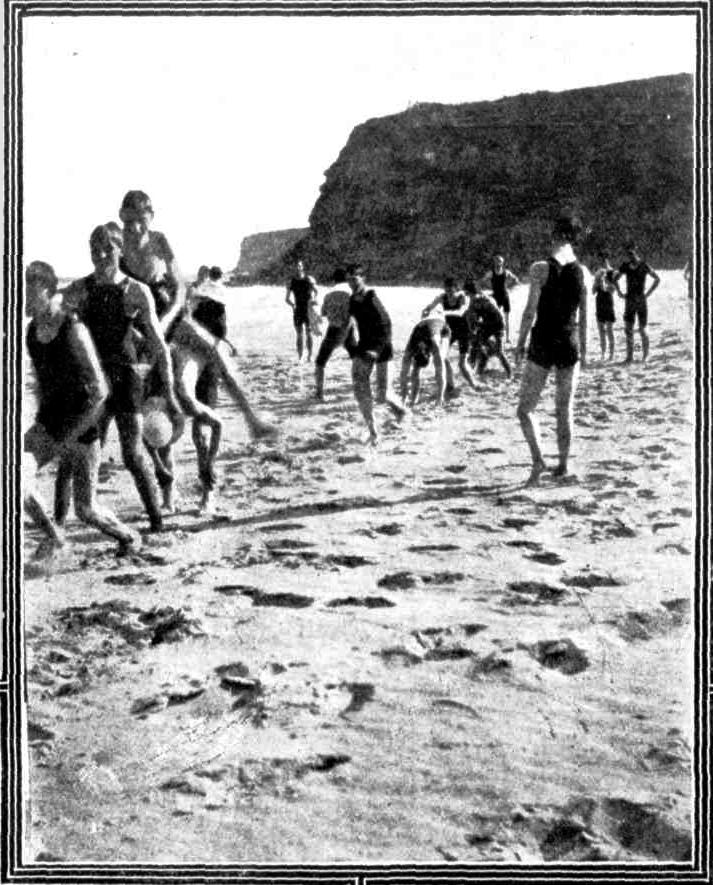
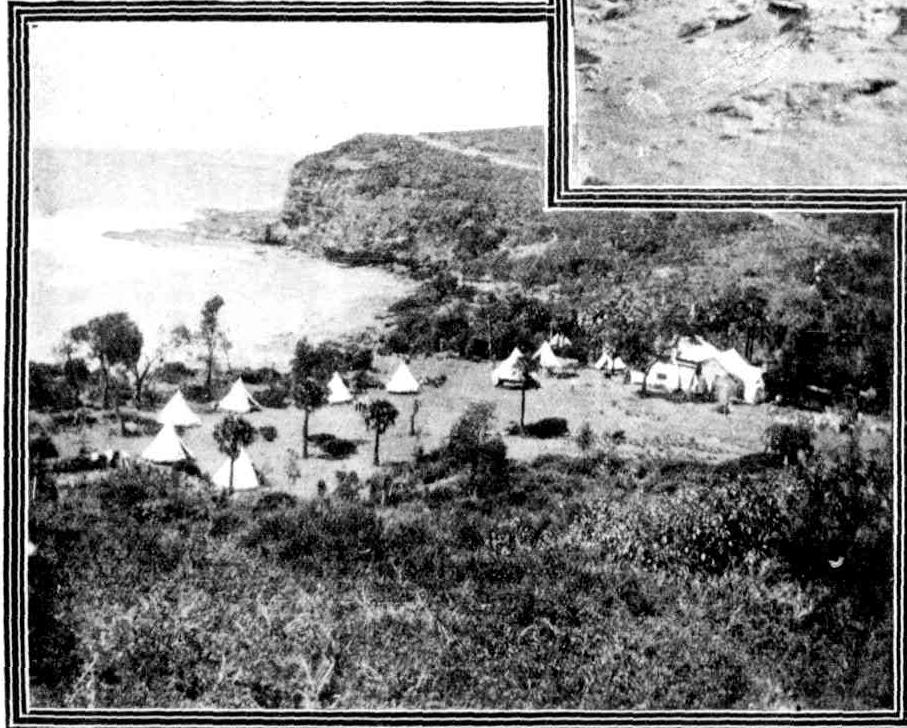
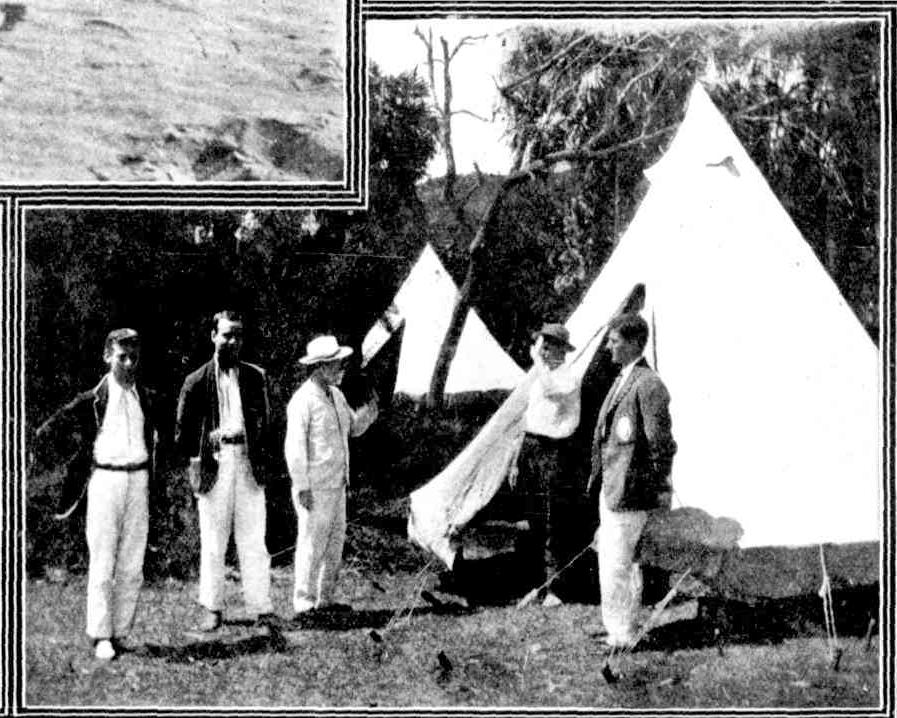
Certain University men recently organised a large camp, specially designed for Great Public Schools. The organisation was complete. The idea was to make it the beginning of an annual affair. In England, Scotland, Ireland, Norway, Sweden, Holland, and the United States these camps for secondary schools are already well known. In England, Oxford and Cambridge men conduct the camps, while boys from such schools as Eton, Rugby, and Harrow attend them. The camp is one of the best places to make friends. The very freshness and freedom of outdoor ife, and the warmth of the Australian sun, help to establish goodwill and comradeship. The headquarters of the Sydney camp were at Dalley's Bungalow, a couple of miles past Newport. The spot is very picturesque, peeping on to a beach through a host of palms. The Bathurst Floods: A 'Varsity Camp. (1909, February 10). The Sydney Mail and New South Wales Advertiser (NSW : 1871 - 1912), p. 34. Retrieved from http://nla.gov.au/nla.news-article163286978
NEXT WEDNESDAY. 6th MARCH. 1912. A CHANCE FOR SUBDIVIDERS. BILGOLA HEAD, NEWPORT. OCEAN FRONTAGE. INCLUDING GLORIOUS SURF BATHING BEACH. ABSOLUTE WATER FRONTAGE. Adjoining Dalley's Bungalow. MAGNIFICENT SUBDIVISION BLOCK. 25 ACRES, 3 ROODS, .. PERCHES, Fronting main Barrenjoey Road, Being lots 24 and 25 of the PITTWATER ESTATE. PLAN ON VIEW AT THE SALEROOMS. TITLE TORRENS. HARDIE AND GORMAN, in conjunction with Percy G. Sharpe, have received instructions to sell the above by Public Auction, at their Sale Rooms, 133 Pitt-street. at 11.30 o'clock .Advertising. (1912, February 28). The Sydney Morning Herald(NSW : 1842 - 1954), p. 14. Retrieved from http://nla.gov.au/nla.news-article15313791
MOTOR CYCLING. The Kookaburra Motor Cycle Club, with Mr A Billerwell as hon secretary, has registered with the N.S.W. Cyclists' Union. Several prominent North Sydney motor cyclists are identified with this club, which promises a big membership. MOTOR CYCLING. (1910, August 19). The Sydney Morning Herald (NSW : 1842 - 1954), p. 10. Retrieved from http://nla.gov.au/nla.news-article15205933
From land records - NSW State Records: Primary Application - Arthur Billerwell 3 acres 1 rood 2 3/4 perches on Bilgola Creek in Shire Warringah Parish Narrabeen County Cumberland Volume 3280 Folio 102 Date range: 30/03/1921 to 04/02/1922
And: Primary Application - William Joseph Hollins 23 acres 1 rood 16 3/4 perches on Bilgola Creek & on a road 1 chain wide leading to the road from Manly to Barrenjoey in Shire Warringah Parish Narrabeen County Cumberland Volume 2570 Folio 171 Date range: 12/06/1914 to 27/04/1915
THE KOOKABURRA'S SECRETARY, MR. A. BILLERWELL. Mr. 'Arthur' Billerwell is another motor-cyclist who graduated from the ranks of the amateur racing cyclist. A few -years ago he was a prominent North Sydney rider, and occupied a position very near scratch in the company of such riders as A. Eiden, who, for several years, held the N.S. Wales record for 20 miles on the road, and was always a competitor with whom no liberties could be taken. Mr. Billerwell, however, was one of the less fortunate riders as a cyclist, for, in spite of his abilities, very few prizes came his way. Taking up motor-cycling a few years ago, Mr. Billerwell was one of the moving spirits in forming the Kookaburra Club, and was, at its first meeting, elected secretary, a position he has filled' ever since. Like many of his club mates, Mr. Billerwell has not confined his athletic energies to one branch, having taken part in a number of swimming events as a member of the Mosman Club ; he is also a skilful surfer. Not long ago, after a long period of motor-cycling, he demonstrated that he had not entirely forgotten how to pedal by riding a hard pursuit match — in which two cyclists start at opposite sides of a track, and ride in pursuit of each other until the agreed on distance is covered— with Mr.' F. S. Roberts at St. Ives, on- a rough pony track. . He is also credited by those who know him with a leaning towards naturalistic studies, being quoted as something of an authority on the habits of ants. THE KOOKABURRA'S SECRETARY,. (1913, February 9).Sunday Times (Sydney, NSW : 1895 - 1930), p. 18. Retrieved fromhttp://nla.gov.au/nla.news-article126460786
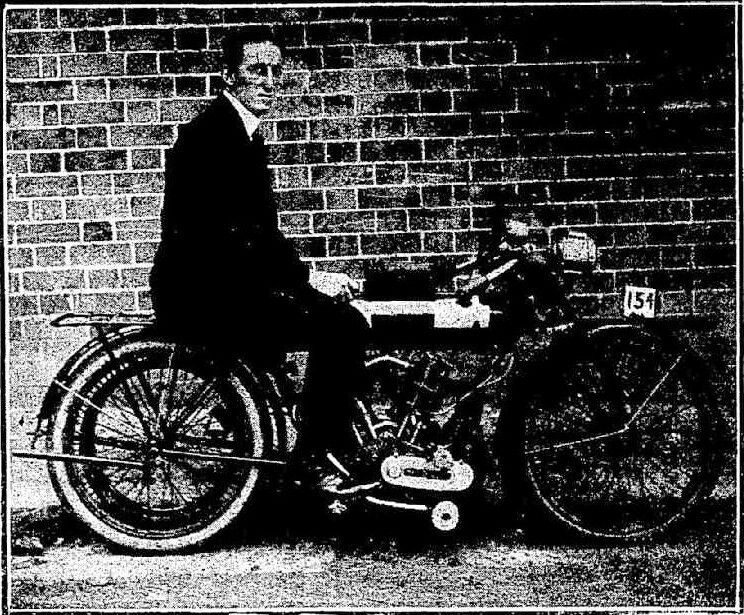
MR. ARTHUR BILLERWELL, Hon. Sec. of the Kookaburra Motor-Cycle Club.MOTORS & MOTORING. (1913, February 9). Sunday Times (Sydney, NSW : 1895 - 1930), p. 18. Retrieved from http://nla.gov.au/nla.news-article126460708
It was during this man's guiding that:
KOOKABURRA MOTOR-CYCLE CLUB. This club has made an important move recently by securing a site for a permanent clubhouse at Newport, where 7 ½ acres of land have been purchased by the camping section at Bilgola, having easy access to the beach. The property purchased is described as picturesque, and possessing many attractive features for those motor-cyclists who have a leaning towards Nature, and its extent will permit of its being made particularly valuable in the future. It is intended to erect a bungalow club-house at once, the building having two rooms and a kitchen, as well as wide verandahs on each side for 'sleeping out.' In addition there will be a smoke room, separated from the main building, in a position where Nature has already almost provided a room. The dining-room and outdoor kitchen are also to be situated a little distance away from the club house, in a beautiful palm grove, close beside the banks of a creek of pure, freshwater. Besides these buildings, the plans include these of a garage with, a suitable; work bench to permit of members overhauling their motorcycle engines on wet days. The club-house will no doubt be the rendezvous of the Kookaburras during the Summer months. The Kookaburra Club's committee has decided, on account of the bad state of the roads, to make a centre to which the majority of club runs will be hel'. The plan selected, has not been divulged at present, but it is stated it offers facilities for football, cricket, or other outdoor games, as well as motorcycle frolics; and two out of every month's week-end runs are to be to it. The other runs will include a week-end tour and a visit to such old motor-cycling haunts as Windsor, Appin, Springwood, etc.-
The migration of Kookaburras from their present Summer quarters is promised for April 13 and once again the birds find themselves connected with mystic 13. It has frequently been commented on how this club flirts with the supposedly unlucky number. The club will hold the opening run of its touring season on April 19 and 20.
ON TOUR. Messrs. A. G. Biden and R. Readford are away at present on a holiday, at Oberon. They rode up on their motor-cycles, and report having found a 'teaser' of a new hill on the way up. At present they are enjoying great relaxation among the rabbits and other game.
A NEW MOTOR-CYCLE CLUB.
At a meeting held on Wednesday evening, a new motor-cycle club, called the Britannia, was formed successfully, about 25 members being enrolled. Mr. A. A. Levi was appointed Hon. secretary, and Mr. d. A. Zink Hon. treasurer/ both pro 'tern. A further meeting is to be -held on Wednesday evening at the Volunteer Hotel, George-street, when other office bearers will be elected. The club's opening run is to take place to-day, leaving the Glaciarium for Newport via Manly at 9.30 a.m. KOOKABURRA MOTOR-CYCLE CLUB. (1913, April 6).Sunday Times (Sydney, NSW : 1895 - 1930), p. 21. Retrieved from http://nla.gov.au/nla.news-article126462062
KOOKABURRA'S NEW SECRETARY. Mr. H. L. Pitt is the new hon. secretary of the Kookaburra Motor Cycle Club, having been elected as successor to Mr. Fred. Holmes, who recently retired from the position. Mr. Pitt is a well-known North Sydney athlete, having been prominent both as a swimmer and footballer, as well as a motor cyclist, and is very popular among members of the Kookaburra as well as other Sydney motor cycle clubs. KOOKABURRA'S NEW SECRETARY. (1913, October 12).Sunday Times (Sydney, NSW : 1895 - 1930), p. 17. Retrieved from http://nla.gov.au/nla.news-article126312754
On Sunday the twelve members' who made the Journey to Narrabeen spent a part of the afternoon on the club ground at Bilgola Beach. The summer camp was found to be damaged by the recent storm, and a new fly was erected over the tent, and maters straightened up generally. This outing, being an Impromptu event, in place of the club run to Galston, which was cancelled owing to he heavy state of the roads (Hornsby Gully being particularly bad), does not count for the attendance medal. Mr. 'W. Allen, a member of the Brisbane M.C. Club, was a guest of the club for the day.
Motor cyclists are advised to leave the Manly side of the Spit-road alone for a time, as a large quantity of new metal has been recently put down, and the road will not be in a rideable condition for at least a fortnight. MOTOR CYCLING. (1913, May 21). The Sydney Morning Herald(NSW : 1842 - 1954), p. 4. Retrieved from http://nla.gov.au/nla.news-article15422162
KOOKABURRA MOTOR CYCLE CLUB. The run for last Sunday was split up. On a section visited Springwood, while another party put in a day cleaning up at the camp site, Bilgola Beach, Newport, after the recent rains. Sidecars are becoming, so popular among the Kookaburras that it is not improbable that special arrangements will be made on future fixture cards for them.
Members this week-end are engaged on a tour through Wollongong, Kiama, Berry Mountains, Kangaroo Valley, Bowral, Moss Vale and the Oaks. The touring party, which left yesterday at midday, was a large one, 17 members having expressed their fixed intention on going, while the party was expected on Friday evening to be swelled to 20. KOOKABURRA MOTOR CYCLE CLUB. (1913, June 8). Sunday Times (Sydney, NSW : 1895 - 1930), p. 21. Retrieved from http://nla.gov.au/nla.news-article126458936
Kookaburra Club:-week-end run to the Kookaburra camp, Bilgola, Newport, starting from the Spit punt this afternoon, at 2.30 o'clock. FIXTURES. (1913, November 1). The Sydney Morning Herald(NSW : 1842 - 1954), p. 24. Retrieved fromhttp://nla.gov.au/nla.news-article15462356
The Kookaburra Clubs week end camp at Bilgola Beach near Narrabeen has been opened for the season and there is evidence of the hard work which has been done gratuitously by members on their off days. Unfortunately the first hill leading off the Newport road In the direction of the camp is in a shocking condition and is quite unrideable but the second hill which was such bugbear last season is now in good order. Motor cyclists travelling over to the Manly, Narrabeen or Frenchs Forest districts via Mosman and the Spit hill will be well advised to take particular notice of the four mile-an-hour speed limit at the top of the Spit hill (Mosman side), which is very much In force at the present time. There is also a speed limit of 15 miles an hour, which is applied with some effect to motorists ascending cither the Mosman or Manly hills fromthe Spit punt, where the authorities now in almost daily attendance on the punt itself are showing marked interest in the currency of licences. The members of. the Kookaburra Club will meet at Biden and Roberts at 8 o'clock this evening to draw up the season's run card. MOTOR CYCLING. (1913, November 5). The Sydney Morning Herald (NSW : 1842 - 1954), p. 5. Retrieved from http://nla.gov.au/nla.news-article15463163
MOTORING. KOOKABURRA MOTOR-CYCLE CLUB. Members of the Kookaburra Club have been invited to spend Boxing Day as guests of the Burrawong Camp Syndicate, at Bilgola, Newport. The hill leading to the camp has lately been much improved, having been re-graded from 1 in 5 to 1 iii 10, and a better road surface made. The flexibility hill-climb, which is the final of the series of competitions in connection with Mr. C. W. Bennett's trophy, has been postponed on several occasions, but will be decided on the first available Saturday afternoon after the new year. This trophy, it will be remembered, was presented to be won by the member with the best aggregate point-score in the club's competitions during the year, and Mr. Fred Holmes, ex-secretary, of the Kookaburras, has so commanding a lead that it is hardly likely, he will be dispossessed of the trophy. But as there are two prizes in the climb it is being anxiously awaited. MOTORING. (1913, December 21). Sunday Times (Sydney, NSW : 1895 - 1930), p. 12. Retrieved fromhttp://nla.gov.au/nla.news-article126317792
Mr Billerwell passed away when only a young man:
MR. ARTHUR BILLERWELL. The funeral of Mr. Arthur Billerwell, who died at his residence Gerard-street, Cremorne, took place In the Independent portion of the Northern Suburbs Cemetery. Mr. Billerwell was well known In the motoring and cycling world, and was 42 yearsof age. He held a responsible position in Messrs, John Sands, Limited, and was a prominent Mason, being accorded a Masonic funeral.OBITUARY. (1924, November 8). The Sydney Morning Herald(NSW : 1842 - 1954), p. 18. Retrieved from http://nla.gov.au/nla.news-article16172255
BILLERWELL - The Relatives and Friends of the late Mr. W ARTHUR BILLERWELL are kindly invited to attend his Funeral; to move from Wood Coffill's Funeral Parlours, 99 Mount-street, North Sydney, THIS (Monday) AFTERNOON, at 2.30 o'clock, for Independent Cemetery, Northern Suburbs, per motor service. Motor 'bus leaves Chatswood Station at 2.45 for Cemetery Gates. By request, no flowers.WOOD COFFILL LIMITED, Motor Funeral Directors. BILLERWELL .-Masonic Brethren of LODGE VIRTUE, 1..04. and STAR of AUSTRALIA, No. 2uu, are respectfully invited to attend the Funeral of late Brother W. A. BILLERWELL, Senior Warden, to leave … J. P. RODGERS, Sec.Family Notices. (1924, November 3). The Sydney Morning Herald (NSW : 1842 - 1954), p. 7. Retrieved from http://nla.gov.au/nla.news-article16158450
The other interesting item regarding early owners of the lands alongside Bilgola Creek is that owned by William Joseph Hollins and this gentleman's other business interests:
On behalf of the plaintiff in the suit of William Joseph Hollins against Norman Moss, an ex parte application was made by Mr. R. K. Manning (Instructed by Messrs. A. S. Boulton and Co.) for an Interim Injunction restraining the defendant from selling, mortgaging, alienating, or otherwise dealing with the Wentworth Park Hotel, Pyrmont, and the license thereof, except under plaintiff's direction.
Plaintiff claimed that by an agreement, dated July 28 last, the defendant agreed to sell to him for £4060 the lease, license, goodwill, and furniture of the hotel. In question upon the following terms:-£200 to be paid to defendant's agents as a deposit on the signing of the agreement; and £3400 to be paid to defendant’s agents, and the balance of £460 to be advanced by Tooth and Co, one day at
least before the transfer of the license. It was further agreed that the matter was to be completed and the transfer made on August 10, or as soon as possible thereafter. He paid the £200 deposit to defendant's agents, and was ready and willing to perform his part of the agreement, but, ho alleged, the defendant had neglected and refused to perform his part, and, In breach of the agreement, had resold the hotel property, and intended to transfer the same and the license otherwise than to him. He did not admit defendant's title to the lease or property, agreed to be sold to him.
His Honor granted an Injunction till Tuesday next, with leave to move to continue It on that day. CANCELLATION OF AN AGREEMENT. LION WHITE LEAD, LTD., v FLETCHER. .The matter is part heard. IN EQUITY. (1922, October 27). The Sydney Morning Herald(NSW : 1842 - 1954), p. 6. Retrieved from http://nla.gov.au/nla.news-article16044457
ALLEGED BREACH OF AGREEMENT. Hollins V-MOSS. The suit of William Joseph Hollins against Norman Moss was before the Court by way of an application listed for hearing on behalf of the plaintiff to continue the interim injunction restraining the defendant from selling, mortgaging, alienating, or otherwise dealing with the Wentworth Park Hotel, Pyrmont, and the license thereof, except under plaintiff's direction. Particulars of the claim have already been published. -
Mr. R. K. Manning (instructed by Messrs, A,S. Boulton and Co.) appeared for the plaintiff; and Mr. J. A. Browne (instructed by Mr. D. R. Hall) for the defendant. His Honor was informed that a settlement had been arrived at, and the matter was accordingly struck out. Under the settlement the deposit of £200 was to be returned to plaintiff, and defendant was to pay £65 for costs. LAW REPORT. (1922, November 11). The Sydney Morning Herald (NSW : 1842 - 1954), p. 9. Retrieved from http://nla.gov.au/nla.news-article28078636
Motor Cyclists were not the only people frequenting Bilgola and her pristine creek as a camping site during these decades and this appetite to be in the great outdoors was matched from before 1900 and then onward with ensuring public places were kept available for all peoples:
BILGOLA BEACH. PROPOSED RESUMPTION OF FORESHORES.
Mr. Wearne (Minister for Lands) yesterday visited Bilgola Bay, north of Newport, and inspected a site which had been proposed as a seaside camp tor bush children. The Minister decided that the spot was too far distant from transport and other facilities, and that it was also unsuitable owing to the absence of life-saving apparatus. It was arranged that Dr. Arthur and Councillor Parr(Shire President) should confer regarding another site at Narrabeen.
The Shire Council asked the Minister to reserve the foreshores of Bilgola Bay and to reserve for park purposes the land between the beach and the eastern side of the main road. It was estimated that the resumptions would cost about £8000.
Mr. Wearne said that the Government should not be expected to bear the cost of the resumption. He suggested that the Shire Council should approach the owners of the land on the western side of the road and endeavour to induce them to contribute one third of the cost. The Shire Council, he thought, should contribute one-third, and on those conditions the Government would consider providing the balance.BILGOLA BEACH. (1925, March 23). The Sydney Morning Herald (NSW : 1842 - 1954), p. 10. Retrieved from http://nla.gov.au/nla.news-article16196468
People like:
EX - SERVICE WOMEN'S CLUB CAMP.
THIS club is open to ex-service women of all branches, but especially those from overseas. Each service is represented on a committee presided over by Dr. Marjorie Little, and from these members help and advice may be obtained. The camp is in charge of Miss N. L. Dickson, the Q.M.A.A.C. representative, and has proved very successful. It is situated on Bilgola Beach, and surfing and swimming in Newport, rock baths are greatly enjoyed. The length of visits to the camp is not limited, but weekends are mostly in favour. One Sunday recently 26 girls made a visit to Lovetts Bay and climbed to the lookout, after which they crossed to Church Point and were entertained by Mrs. Black (of Manly), whose hospitality was greatly appreciated.
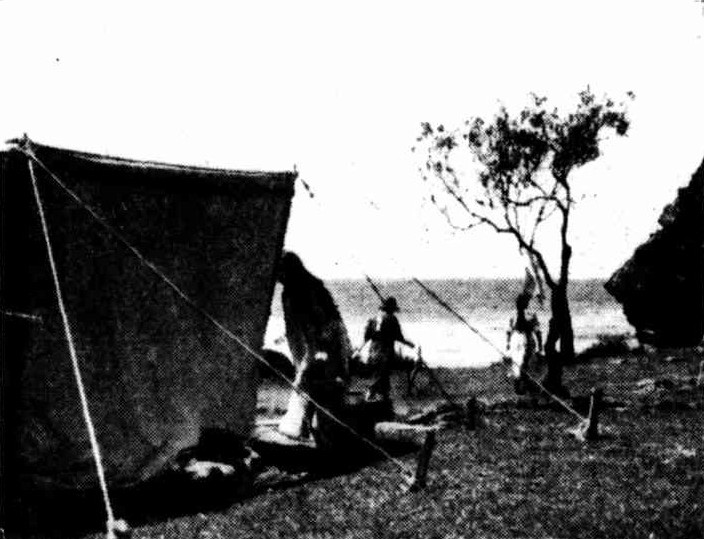
On Bilgola Beach.
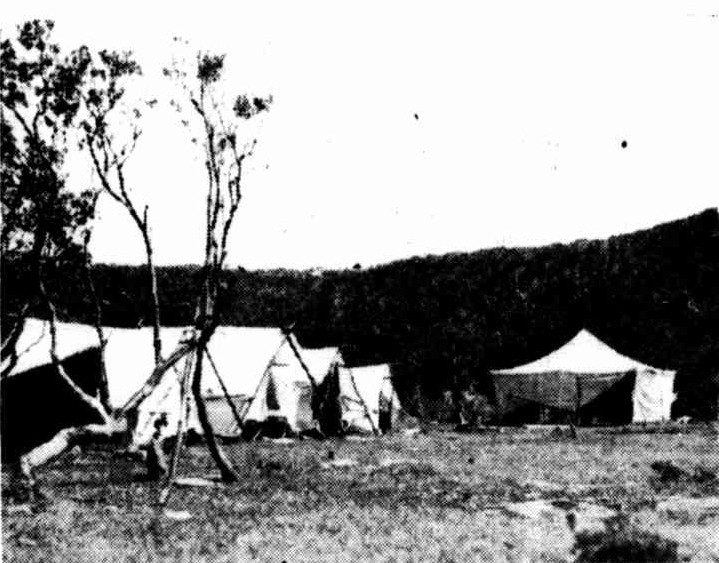
The Camp at Bilgola Beach.
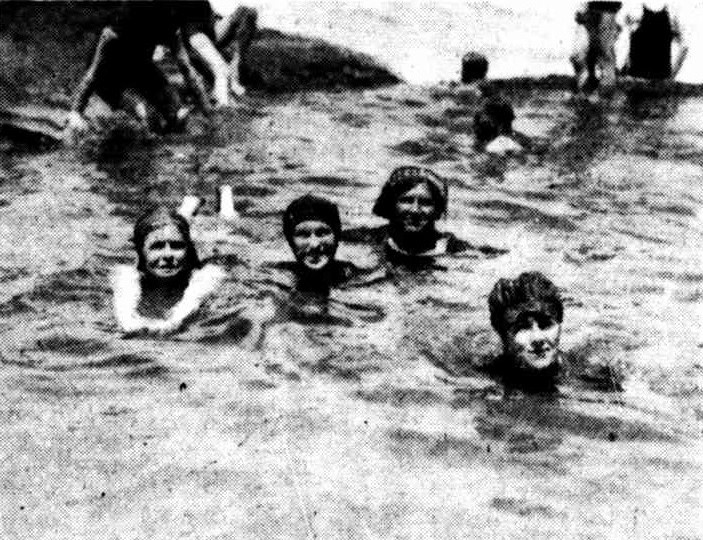
In Newport Rock Baths.
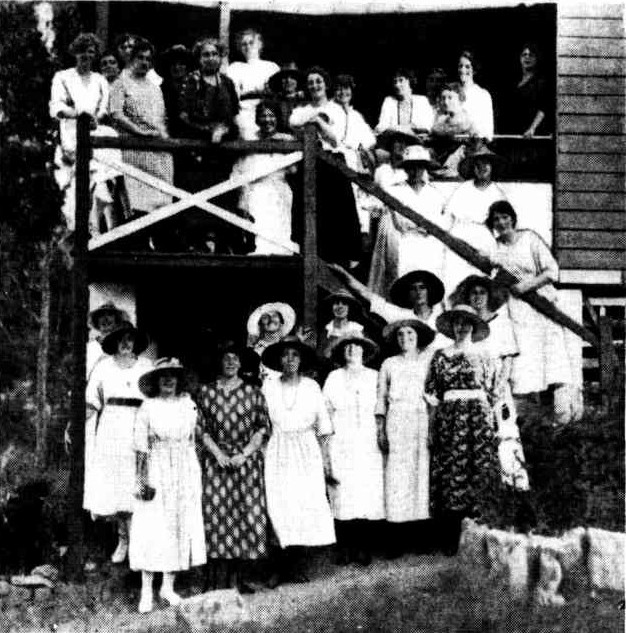
At Church Point.
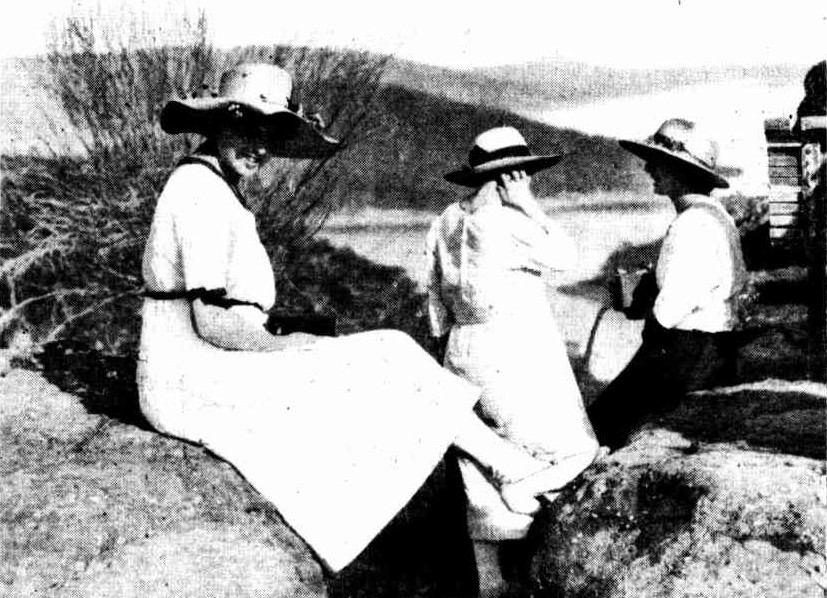
At Lovett's Bay Lookout.
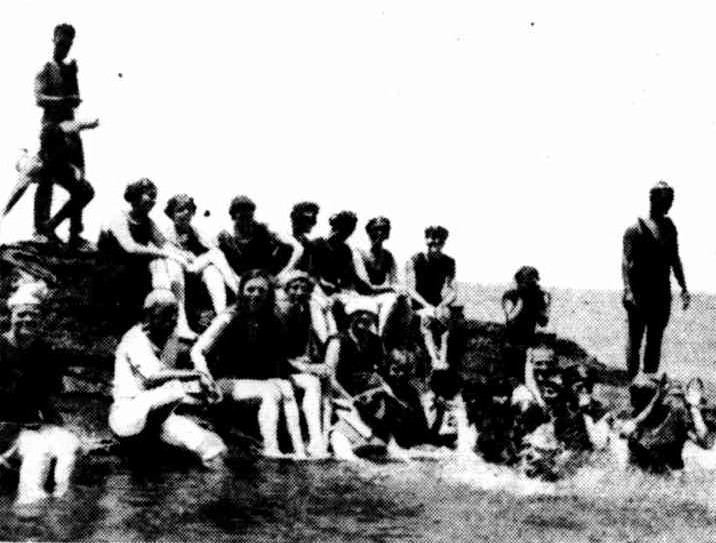
Enjoying the Sun.
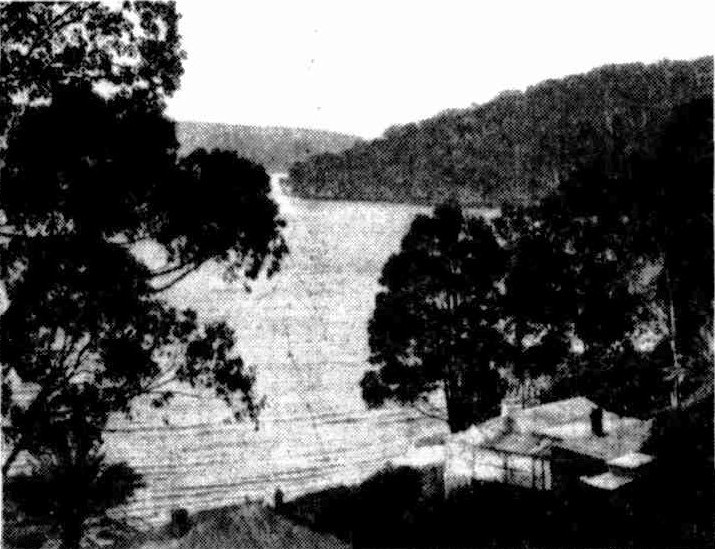
View from Church Point.
(Photos: P. A. Peachey.)
EX-SERVICE WOMEN'S CLUB CAMP. (1922, March 8). Sydney Mail (NSW : 1912 - 1938), p. 22. Retrieved fromhttp://nla.gov.au/nla.news-article169771675
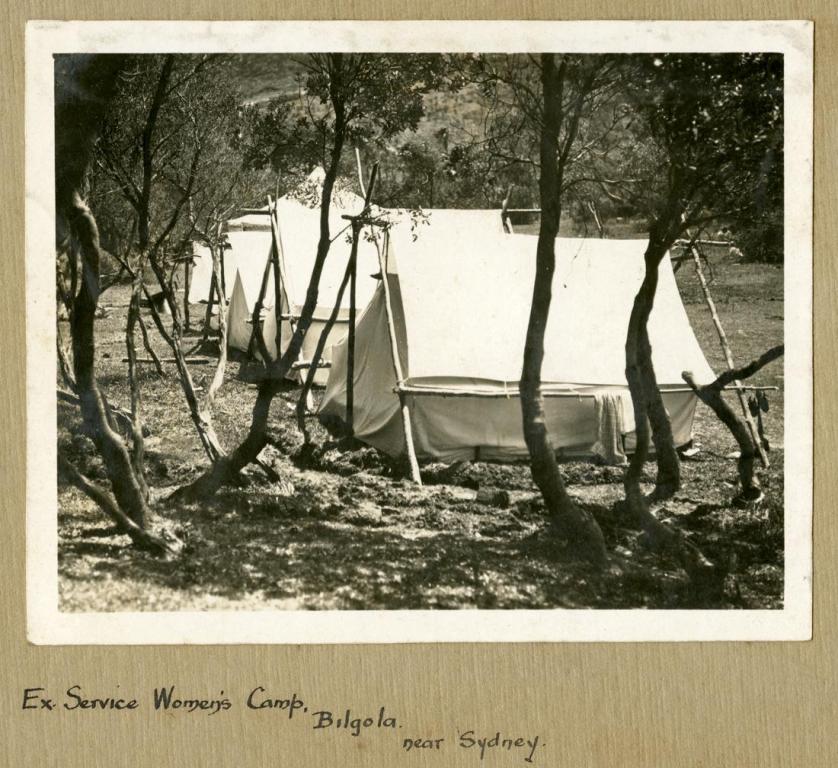
Women's Camp at Bilgola Beach - picture courtesy Anne Spencer
Although some of these newspaper photographs are a bit dark they do allow us to glimpse Bilgola's changes, and some of her other visitors, who clearly could still drink the water's of Bilgola creek, and even have evidence that Bilgola's beauty caused thta name to be mentioned at least once each Summer:
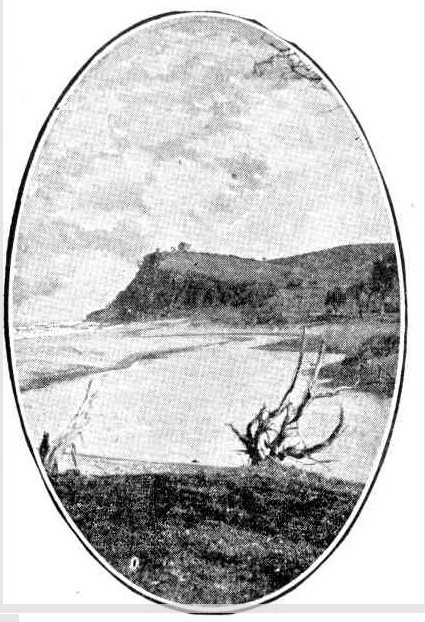
A glimpse of Bilgola Beach, Newport. Glimpses of a Day in Your Holidays. (1927, December 11).Sunday Times (Sydney, NSW : 1895 - 1930), p. 5. Retrieved from http://nla.gov.au/nla.news-article128507527
ON THE ROAD TO NEWPORT, BILGOLA, AND PALM BEACH.
The volume of traffic along this road at week-ends and on holidays is tremendous. The parking of the cars on either side of the road, as shown in the photograph, is accounted for by the desire of the motorist to see aeroplane flights from the landing-ground at Narrabeen Lake. MOTORING. (1929, February 13). Sydney Mail (NSW : 1912 - 1938), p. 45. Retrieved from http://nla.gov.au/nla.news-article166257683
Whale Beach This is one of many beautiful beaches between Manly and Barrenjoey. That part of the coastline is rich in beaches and includes Manly, Harbord, Curl Curl, Dee Why, Collaroy, Narrabeen, Mona Vale, Newport, Bilgola, Avalon, Whale and Palm Beaches and several smaller beaches. With the exception of Manly all the beaches mentioned are in the Warringah Shire, which consists of the comparatively narrow strip of land between the northern boundary of Manly and Barrenjoey' headland. Harbour and Ocean Scenes North of Sydney. (1930, March 19).Sydney Mail (NSW : 1912 - 1938), p. 11. Retrieved from http://nla.gov.au/nla.news-article160630537

'View of Bilgola from the hill' Bilgola 1930, courtesy National Library of Australia, Picture an24768552-v. Tents can be seen where the clubhouse now stands and the Norfolk Pines have only just been planted.
CAMPING - She's Booked !
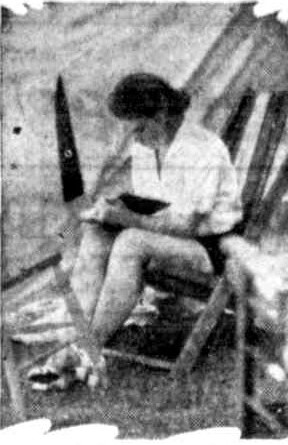
YES, and the young lady enjoying her Christmas holiday at Bilgola Beach doesn't want any interruption, thank you. She's Booked!. (1934, December 26). The Newcastle Sun(NSW : 1918 - 1954), p. 2. Retrieved from http://nla.gov.au/nla.news-article166292847
And then:
CAMPING AT BILGOLA.
Although the Warringah Shire Council, according to a recent press report, decided to allow camping at Bilgola Beach, the N.R.M.A. has since received advice from the Council that its decision to allow camping at this place has been rescinded, and therefore motorists wishing to camp will have to patronize the recognised grounds at Narrabeen, Avalon Beach and Palm Beach. CAMPING AT BILGOLA. (1936, November 5). Catholic Freeman's Journal (Sydney, NSW : 1933 - 1942), p. 13. Retrieved from http://nla.gov.au/nla.news-article146393315
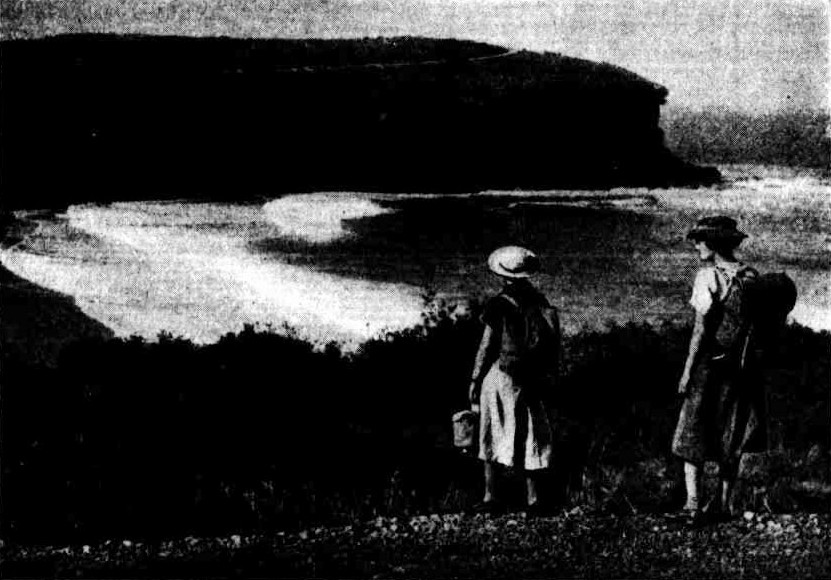
THE CLIFF ROAD, BILGOLA, BETWEEN MANLY AND BARRENJOEY. No title. (1937, November 24). Sydney Mail (NSW : 1912 - 1938), p. 48. Retrieved from http://nla.gov.au/nla.news-article160498181
While all this enjoyment of the natural beauty available at Bilgola was going on, so was the quarry which may have not helped the pristine qualities of Bilgola Creek:
WILD LIFE. No Fear of Bird Poisonings.
The Wild Life Preservation Society wrote recently to the Department of Agriculture pointing out the apparent danger of grass-hopper poison to wild birds. The society decided to unite with other bodies in a protest to the Government regarding the Main Roads Board's use of a section of a tourist road near Bilgola Beach, as a quarry. WILD LIFE. (1934, November 28). The Sydney Morning Herald(NSW : 1842 - 1954), p. 14. Retrieved from http://nla.gov.au/nla.news-article17133917
These were Depression years in Australia though and no government was going to place people being employed before such considerations. The quarry existed for quite a few years prior to being discontinued:
NARRABEEN LAKES. Mr. H. P. Fitzsimons (Honorary Minister)will receive a deputation on Tuesday from the Town Planning Association and kindred bodies, which will ask for the cancellation of the dredging lease in Narrabeen Lakes and protest against the Main Roads Board's quarry in Barrenjoey-road, near Bilgola Beach. NARRABEEN LAKES. (1934, December 10). The Sydney Morning Herald(NSW : 1842 - 1954), p. 4. Retrieved from http://nla.gov.au/nla.news-article17130700
There are also the people behind the building of the first Avalon Beach SLSC Clubhouse and development f Avalon involved here as well as the folk behind Australia's first flight, see First to Fly in Australia at North Narrabeen, and Narrabeen's Ocean House and Billabong :
NARRABEEN LAKE. Protest Against Dredging Lease. A deputation yesterday protested to the Assistant Minister (Mr. Fitzsimons) against the proposal to grant a shell-dredging lease for Narrabeen Lake. Mr. A. E. Reid, M.L.A.. who Introduced the deputation, said it sought protection of the public's playgrounds against commercial exploitation. It was contended that the lease applied for at the lake entrance, would permit the lessee to turn a salt water lake into a fresh water lake, as the terms of the lease permitted the erection of tide gates.
Mr. B. W. Ford, president of the Town Planning Association, said that Narrabeen Lake was one of the most beautiful and popular recreation areas around Sydney. If dredging for shell was permitted the lake would be spoiled. He understood it was proposed to establish cement works with shell-dredging, but the locality should not be commercialised. If dredging was necessary it should be done under Government control and expert supervision.
Mr. A. J. Small, acting president of the Parks and Playgrounds Movement, said that the Mines Department was not required to consult any other body or department. The Lands Department would not have granted such a lease. The lessee's proposals would, result in the dredging of a channel 20 feet deep, while the spoil from the lake bottom, if deposited on the bank, would create a public nuisance.
Dr. Bean, secretary of the Parks and Playgrounds Movement, said the Warringah Shire Council had made a mistake when it approved the lease. The destruction of one of the most beautiful natural playgrounds should not be risked for the sake of one private enterprise. Mrs. Florence Taylor supported the protest.
The deputation also protested against the opening by the Main Roads Department of a quarry on the main road above Bilgoela Beach.
Mr. Fitzsimons, in reply, said that the problem of the dredging lease seemed to be difficult, as the lease had been approved and a company had been formed to operate under it. All he could do was to bring the representations before the Cabinet. The quarry question also was difficult. The Main Roads Department was autonomous, and the arrangement it had made with the shire council was one within its powers. He was sure the Main Roads Commissioner would give sympathetic consideration to the protest. He would bring the matter before the Minister for Transport. NARRABEEN LAKE. (1934, December 12). The Sydney Morning Herald (NSW : 1842 - 1954), p. 21. Retrieved from http://nla.gov.au/nla.news-article17124456
The movement's protest against the opening of a quarry at Bilgola was mentioned. The honorary secretary (Dr. C. E. W. Bean) announced that he had received advice from the Premier that the Main Roads Commissioner (Mr. H. H. Newell) would visit Bilgola with representatives of the movement on March 30 to see the effect which the quarry was having on the natural scenery.
Mr. A. J. Small, who presided, said that they had the Premier's assurance that the preservation of the State's natural scenery would at all times receive the fullest consideration. SHARK MENACE. (1935, March 14). The Sydney Morning Herald (NSW : 1842 - 1954), p. 7. Retrieved from http://nla.gov.au/nla.news-article17171400
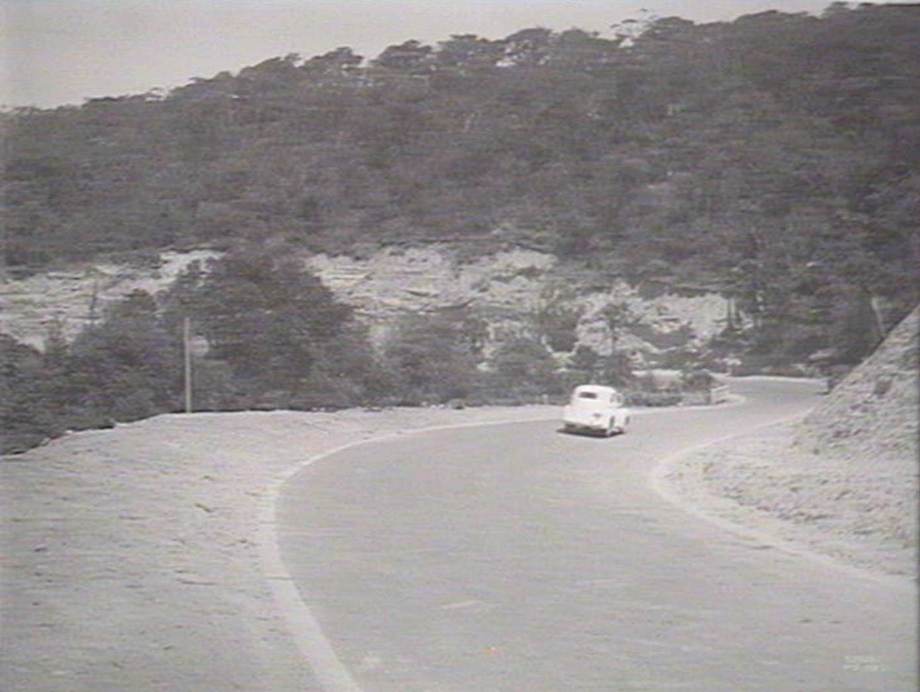
Barrenjoey Road looking south: north of quarry, Bilgola - 10/3/1938, Image No.: Government Printing Office 1 - 21340, d1_21340, courtesy State Library of NSW
TOWN PLANNING. Criticism of Bilgola Quarry.
The action of the Main Roads Department in establishing a quarry and roadmakers' camp at Bilgola on the Palm Beach-road was described by Mr A J Small at a meeting of the Town Planning Association oí New South Wales yesterday as a permanent blot on the administration of the department" He declared that the work was damaging to the interests of the State especially to tourist traffic as wonderful scenery had been spoiled.
The association decided to arrange a deputation to the Premier (Mr Stevens) with the object of having the work stopped. Dr C E W Bean advocated action with a view lo giving local councils greater control over the building of flats He said that the practice of building a block of flats on the whole of an area of ground without providing adequate space for gardens or yards was an evil which was bound to result in the creation of slum areas... TOWN PLANNING. (1935, May 10). The Sydney Morning Herald (NSW : 1842 - 1954), p. 5. Retrieved fromhttp://nla.gov.au/nla.news-article17145002
BILGOLA QUARRY. As a result of a promise by the Premier the Main Roads Commissioner (Mr Newell)on Saturday conferred with objectors to the quarry opened by the Main Roads Department between Newport and Avalon, near Bilgola Beach. It was pointed out that the quarry would spoil the beautiful scenic road. It was suggested that the department's operations should be transferred to the Shire Council's quarry. Mr Newell promised consideration of the request, and said he would give a decision as soon as possible. THE SUBURBS. (1935, April 2). The Sydney Morning Herald(NSW : 1842 - 1954), p. 6. Retrieved from http://nla.gov.au/nla.news-article17149458
But over a year later, with dust still rising in clouds that may have been making relief workers ill, to say nothing of hat it would have been doing to the Bilgola gardens and creeks....:
Dr. Badham, of the Health Department, paid a visit of inspection to the quarry and crusher at Bilgola last week, but as the machinery had been laid aside for a week pending repairs, it will be necessary for the doctor to make a further inspection later on, and at an early date. THE BUSHWORKERS' BUDGET. (1936, August 5). The Australian Worker (Sydney, NSW : 1913 - 1950), p. 17. Retrieved fromhttp://nla.gov.au/nla.news-article146017700
SOUTH COAST ROAD JOBS. ORGANISER T. DALTON'S REPORT. Last week. I visited Main Roads job On the South Coast, the first, visited being Cockwhy Creek. Alf Martin was appointed Rep. of J. Milligan's gang, it is anticipated that this gang will shortly be transferred to other gangs along the coast. Single unemployed men from Sydney, it is expected, will be sent by the Department to Cockwhy to work for a whole 24 hours per week. If this proves to be the case it will be further proof of the starvation policy of the present Government as regardsrelief work.
In company with Mr. H. Court I also visited last week the Bilgola Quarry,' where Mr. Badham made an inspection of the crushing plant in relation to the dust arising there from. Tests were made of dust taken, and I have no doubt that the doctor will recommend an alteration of the conditions that exist there. TOM DALTON. SOUTH COAST ROAD JOBS. (1936, October 14). The Australian Worker (Sydney, NSW : 1913 - 1950), p. 17. Retrieved from http://nla.gov.au/nla.news-article146021562
M.R.B. BILGOLA QUARRY AND PRE -MIXING PLANT. This job is being carried out by the Department of Main Roads. All told there are 28 men employed. At the quarry Ted Keating is still holding down the position of Rep., and reports all matters from a Union point of view as being highly satisfactory. In Hallagan's tar gang Rep. John Dicken is attending to the industrial interests of the members. In every section throughout the job I am pleased to be able to report a 100 per cent, membership. This creditable condition of affairs is due solely to the efforts of Rep. Ted Keating and John Dicken, who since the commencement of this job have been active in ensuring that award conditions were carried out. The matter relating to the pre-mixing plant has been handed to Secretary Jack McNeill, who will advise the seven members concerned. I have to add that this matter was not previously brought to the notice of Secretary Jack McNeill as members believed. PRESIDENT DALTON'S REPORT. (1936, May 13). The Australian Worker (Sydney, NSW : 1913 - 1950), p. 17. Retrieved from http://nla.gov.au/nla.news-article146019509
And with the Bilgola Reserves being placed off the camp registers, although there was still Avalon Beach Camping Grounds, and the continuing use of this small area as a quarry, the need for water etc fr 28+ workers and their families, as well as the obvious pollution such practices create, :
I am advised by the Secretary of the Department of Main Roads that suitable sanitary accommodation and adequate drinking and washing water are now provided at the Department's depot at Bilgola. N.S.W. Construction Dept. (1941, November 19). The Australian Worker (Sydney, NSW : 1913 - 1950), p. 12. Retrieved from http://nla.gov.au/nla.news-article146237368
What is interesting regarding the above lack of water and sanitary works is that water to Avalon had only occurred a few years before and continued to be a problem, especially during times of bushfires:
FIGHT WITH FIRE NEAR AVALON. MEN ALMOST TRAPPED. REFUGE IN WELL.
For five hours yesterday bushfires threatened about 100 homes and week-end dwellings on the hills at the back of Avalon. Fanned by a south-easterly wind, the fires swept down from the plateau and burnt through light timber and grass near Pittwater.
One of the volunteer fighters, A. Butler, of Narrabeen, and a fireman, were surrounded by flames and almost suffocated by thick smoke. They crawled 18ft down a well in the yard at one of the houses. After 10minutes, the smoke forced them to climb to the surface, but the fire had then burnt itself out.
Constable Simpson, of Mona Vale, who reached Avalon first, telephoned for aid. Afire tender with five men under Station-officer Bissett was sent from headquarters, and eight members of the Narrabeen volunteer brigade hurried to the area. Sergeant Huckins and three constables, from Narrabeen, and Con-stable Gold, from Manly, also Joined the fighters.
BREAKS AROUND HOUSES.
While some of the men fought the advancing flames others burnt breaks around homes from Clairville to Taylor's Point. At Hill-top-road the fire was beaten back from eight houses.
On the sea side of the hills the homes of Colonel Johnson, Colonel Reynolds, and Mr. A. R. Harris were threatened, and at Mr. R Row's Cabbage Trees Estate, 400 yards away, the flames scorched the garage near the house. Mr. R. Wilson's stone house was blackened by flames. At many places hoses were used to fight the fire. Water was connected to Avalon only a fortnight ago. Russell Brown, a Boy Scout from Goulburn, joined the fire fighters. Constable Brown said: "He carried hoses, turned on taps, and worked harder than any of us. His assistance was most valuable." FIGHT WITH FIRE NEAR AVALON. (1936, November 13). The Sydney Morning Herald (NSW : 1842 - 1954), p. 10. Retrieved from http://nla.gov.au/nla.news-article17287935
Bilgola, for many of us, since the days of the Bilgola Bop Band, has been a place to party and Bilgola Beach or House, even when just a place to rent out as a Summer weekender or drop in for a cup of tea, was the place and gardens to be. It is also a destination where people, alike a recent lady, Anne Spencer, have done a lot of hard work for a long time to benefit others:
HAWAIIAN BEACH SCENE. Party at Bilgola. CONCERT AT NIGHT. A grove of glorious palm trees with sloping lawns underneath and a shelter built of palm tree branches was a perfect setting for the Hawaiian Beach party, held at Bilgola Beach yesterday, and it looked most picturesque at night when the party ended with a camp-fire and Hawaiian concert. The party was In aid of the Sydney Industrial Blind Institution, and was held at the home of Mrs. M. Thornell, and the adjoining property, belonging to Mr. L. Marks. To increase the Hawaiian atmosphere strolling players wandered through the grounds all day, members of the committee which organised the party wore hula skirts, and nearly all the girls and many of the men wore gaily coloured leis, which were distributed by Mrs. M. Perray. Playsuits, slacks, Hawaiian beach coults, beach coats, and shorts all vied for first place as the choice of the girls who were among the 300 guests at the party. There was a beauty parlour for them to have their faces made up and hair dressed after their surf if they wished. The joint honorary secretaries, Mrs. G. Simpson Millar, who wore a black playsuit with white stripes, and Miss Valeria Horne, wore a beige pink mesh shirt with brown shorts, were busy with the organising, and one of their jobs before the party had been to send out 1000 invitations. For swimming Miss Horne wore an American swim suit of burgundy rubber. Miss Lesley Turner, who is president of the Younger Set appeal committee, which arranged the party, wore a navy blue and white figured playsuit and wide-brimmed matching hat and added a knee-length navy blue cape. Glare glasses were popular, and Miss Jean Gibson wore a pair of green glasses with a white sports frock, at the neck of which she knotted a green scarf.
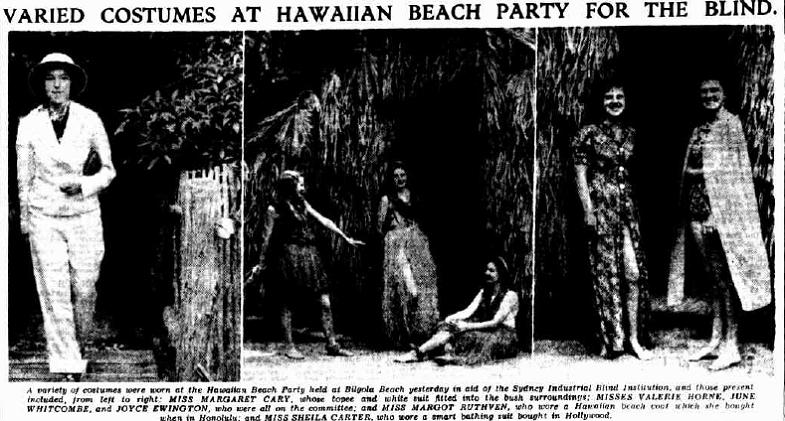
FROM HAWAII. Miss Joan Hodgson wore a beach suit which she brought with her from Hawaii. The slacks were of cream flannel and the navy. "MRS." M. THORNELL in a cool, shady corner of the garden of her home at Bilgola Beach, which she lent for the Hawaiian Beach Party, held yesterday in aid of the Sydney Industrial Blind Institution, whose blue coat had the Hawaiian coat of arms on the pocket. Miss Pamela Roberts, who was with Miss Lorna Hagon, chose a mustard yellow playsuit. Miss Nancy Holland wore a black and white beach hat with a black and White ensemble and added a carved scarlet bracelet. With Mr. Eric Luscombe Newman, was Mrs. Newman, who wore a brown and white playsuit. S.O.S. PATTERN. Miss Patricia Godson's white playsuit was patterned all over with the letters "S.O.S.," and her sister. Miss Babette Godson, chose an Alice blue and white rleured playsuit. Navy blue shorts and a navy blue shirt were chosen by Miss Ruth Wells and about her neck she tied a lipstick red scarf. Navy blue was the choice, too, of Miss Rhoda Clarke, who wore shorts and a shirt, and with grey slacks Miss Shirley Poynter wore an Alice blue shirt. Miss Marie Cohen chose a sky blue and white figured playsuit, and Miss Gwen Sheridan wore a backless linen frock. Miss Gloria Moore Gosgrave wore a yellow top with blue pyjamas, and Miss Audrey Wilkinson wore a navy blue and white Hawaiian beach coat. Miss Nildra Leonard wore a yellow rubber swim suit. HAWAIIAN BEACH SCENE. (1937, November 22). The Sydney Morning Herald (NSW : 1842 - 1954), p. 5. Retrieved from http://nla.gov.au/nla.news-article17413360
FOR WOMEN VARIED COSTUMES AT HAWAIIAN BEACH PARTY FOR THE BLIND.
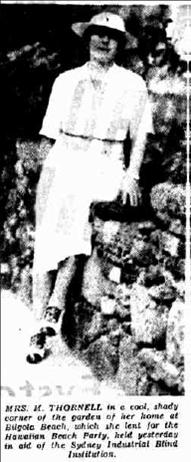
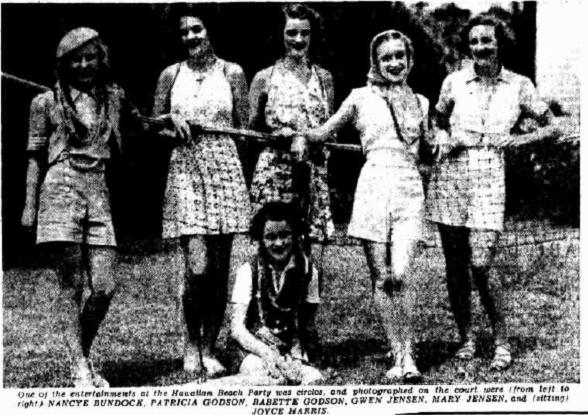
A variety of costumes were worn at the Hawaiian Beach Party held at Bilgola Beach yesterday in aid of the Sydney Industrial Blind Institution, and those present included, from left to right MISS MARGARET CARY, whose tome and white suit fitted into the bush surroundings, MISSES VALERIE HORNE, JUNEWHITCOMBE, and JOYCE EWINGTON who were all on the committee, and MISS MARGOT RUTHVEN, who wore a Hananan beach coat which she bought when in Honolulu, and MISS SHEILA CARTER, who wore a smart bathing suit bought in Hollywood. One of the entertainments at the Hawaiian Beach Party was circles, and photographed on the court were (from left to |right) NANCYE BUNDOCK, PATRICIA GODSON, BABETTE GODSON, GWEN JENSEN, MARY JENSEN, and (sitting) JOYCE HARRIS. FOR WOMEN. (1937, November 22). The Sydney Morning Herald (NSW : 1842 - 1954), p. 5. Retrieved from http://nla.gov.au/nla.news-article17413362
Planning Beach Barbecue
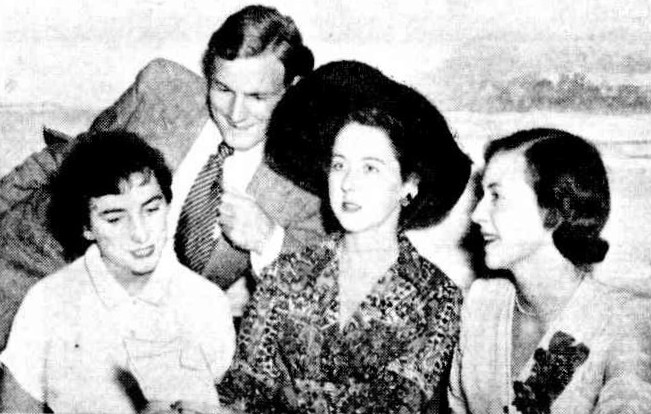
MEMBERS of the Anti T.B. Association Younger Set: MISS MONICA MYERS (co-secretary),MR. JOHN STEINWADE(treasurer), MISS BARBARA TUIT (president)and MISS ELIZABETHMANNERS (secretary), who are arranging a barbecue to be held at Bilgola Beach on February 28. THEY ROSE AT THE DAWN TO BE MARRIED BY SEVEN. (1953, February 15). The Sunday Herald (Sydney, NSW : 1949 - 1953), p. 28. Retrieved from http://nla.gov.au/nla.news-article18513390
Pittwater Online News previous History pages on Bilgola + a few Incidentals
- Bilgola Cottage and House
- Walter Oswald Watt - Pittwater Aviators month
- Dame Nellie Melba lunches at Bilgola Spring, 1914
- Bilgola - Beach and Valley Environment History
- Bilgola SLSC - the First 10 years
Extras:
Death of Colonel Watt — Empire Sunday in Sydney
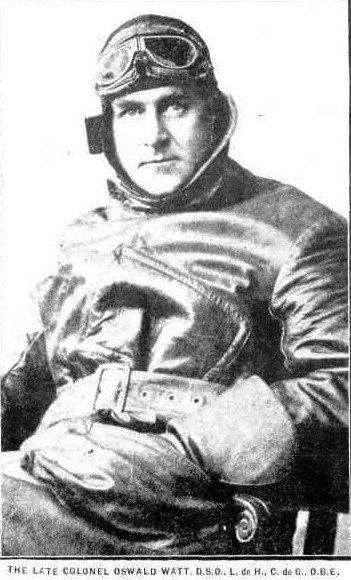 Right: The LATE COLONEL OSWALD WATT, D.S.O., L. de H., C. de G., O.B.E.
Right: The LATE COLONEL OSWALD WATT, D.S.O., L. de H., C. de G., O.B.E.
COLONEL . OSWALD WALTER WATT, who served throughout the war, and had a most distinguished aerial record, was drowned at Bilgola Beach, near Newport, on Saturday morning. The news ''created general regret, for he was exceedingly popular, especially among the men who had served with him in France and Egypt. Colonel Watt was staying at his week-end residence at Bilgola, the only other occupant of the house being the caretaker. He was accustomed to have a swim every morning, and on this occasion he went off to the beach as usual with his towel on his arm and his dressing-gown covering his bathing
suit. It is believed that he was engaged in collecting wood brought in by the tide, and that, slipping on the rocks, he was stunned, and fell into the water. The caretaker, noticing the body floating, hurried to Newport for assistance, and some fishermen, who went out in a boat, recovered the body. Colonel Watt was a director of the firm of Messrs. Gilchrist, Watt, and Sanderson, Ltd., which was founded in 1851 by his father, the late Mr. John Brown Watt, M.L.C.
He was born at Bournemouth, England, in 1878, and after a successful scholastic career at Cambridge University came to Sydney in 1900. Two years later he married Miss Muriel Williams, daughter of Mr. Justice Williams, of Victoria. He left a son, aged 15 years, who is now at Wellington College, England.
His magnificent work in the war is well known. First, he served as an aviator with the French army, and was awarded both the Legion of Honour and the Croix de Guerre. Subsequently he joined the Australian Flying Service in Egypt as major, and soon afterwards took the No. 2 Squadron to England, flying his squadron of24 machines across the Channel to France.
The record of that squadron was a magnificent one. In 1917 Colonel Watt was appointed to command the new training wing at Tetbury, Gloucestershire. He returned to Australia in June, 1919, in charge of the troopship Kaiser-i-Hind. The funeral took place on Monday with military honours.
COLONEL WATT'S WEEK-END RESIDENCE AT BILGOLA BEACH. (below)
The Colonel is believed to have slipped, on the rocks a the right, and to have been stunned by the fall. His body was found some little distance out. Death of Colonel Watt —Empire Sunday in Sydney. (1921, May 25). Sydney Mail (NSW : 1912 - 1938), p. 15. Retrieved from http://nla.gov.au/nla.news-article159038798
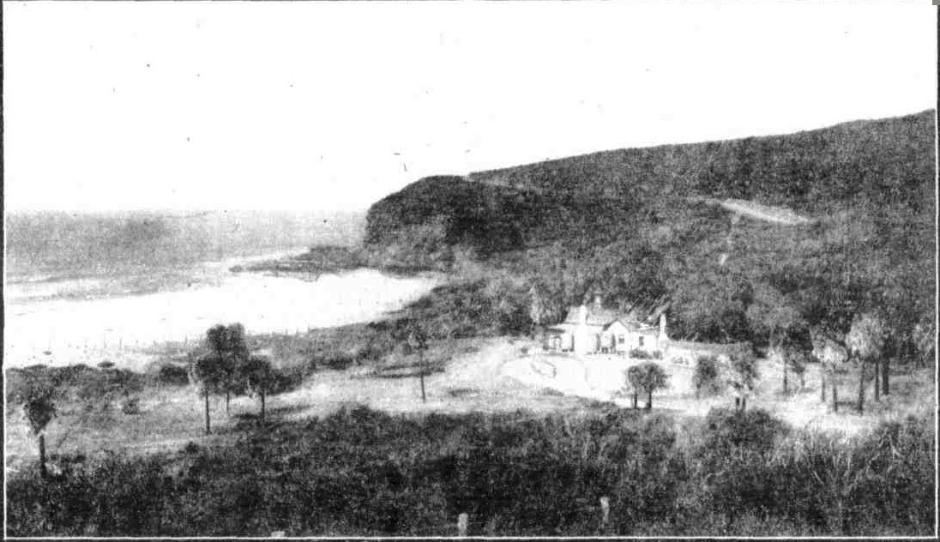
COLONEL WATT'S WEEK-END RESIDENCE AT BILGOLA BEACH. The Colonel is believed to have slipped, on the rocks a the right, and to have been stunned by the fall. His body was found some little distance out. Death of Colonel Watt —Empire Sunday in Sydney. (1921, May 25). Sydney Mail (NSW : 1912 - 1938), p. 15. Retrieved from http://nla.gov.au/nla.news-article159038798
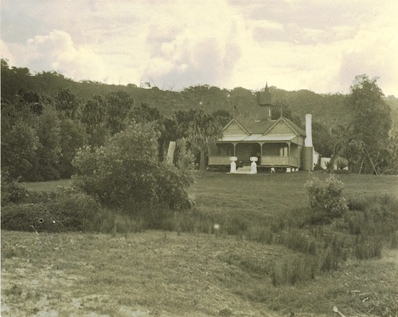
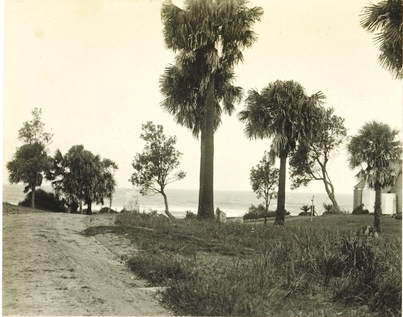
.jpg?timestamp=1336225266472)
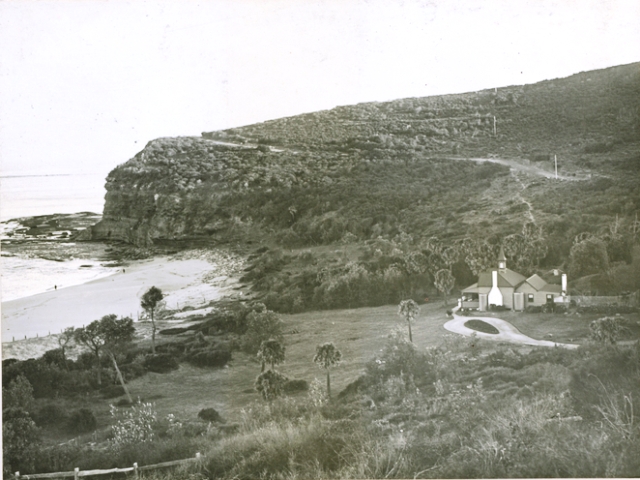
Above from: (top) Album 56: Photographs of the Allen family, 1 December - 30 April 1911 Image No. a3288035h and last is from Album 62: Photographs of the Allen family, 11 May 1913 - 15 October 1913, Image No. a3291037, all courtesy State Library of NSW
Interestingly this 1966 Costume Party for 200 people at Bilgola paid tribute to aviators and a recently released popular film – lots of in colour photographs:
Those Magnificent Men . . . Theme for a bright party - Ten young hosts based the idea of their party on the current film "Those Magnificent Men in their Flying Machines" at the Bilgola home of Mr. and Mrs. Max Brunninghausen. Those Magnificent Men....Theme for a bright party. (1966, January 5). The Australian Women's Weekly (1933 - 1982), p. 13. Retrieved from http://nla.gov.au/nla.news-article47250437
MRS. MACLURCAN LEE. Death Announced
The death occurred on Sunday, at St. Vincent's private hospital, of Mrs. Hannah Maclurcan Lee, formerly governing director of the Wentworth Hotel. She was 73 years of age.
Mrs. Maclurcan Lee, who is better known as Mrs. Maclurcan, came to Sydney in 1901, when she bought the Wentworth Hotel-"with 30 rooms and an unpopular name," she once said. She herself did all the cooking for two years with only the help of two Chinese boys in the kitchen. The venture was an unusually large business undertaking for a woman in those days, and when, in 1912, the Went-worth Hotel was formed into a limited liability company, she became governing director-a position she retained for more than 20 years. During that time she bought land on either side of the hotel, and remodelled and rebuilt until she had a modern hotel.
A daughter of Mr. A. Phillips, of Brisbane, who owned a number of hotels, Mrs. Maclurcan gained a thorough knowledge of the business at a very early age. Her father put her into the kitchen of his hotel at Townsville, and she worked through the dining room to the office, until she knew how to organise and manage. When her chefs re-fused duty at the Wentworth Hotel some years ago, she locked the gates on them and took on new men. When she was only 15 years of age, her son, Mr. Charles Maclurcan said, she was manager for her father of the Club
Hotel in Toowoomba.
Mrs. Maclurcan's Cookery Book, published first in 1898, has achieved wide fame. She helped the Townsville printers to set the type, and when the establishment ran out of type she bought some more. The first edition sold out in a fortnight; the second edition was published In Sydney; and the third in London, at the time of the jubilee of Queen Victoria, who accepted a copy. Until 1929 there was a new edition almost every year.
Mrs. Maclurcan Lee was actively associated with the management of the Wentworth Hotel until within four years of her death. All her life charitable committees found in her a ready helper, and her advice was eagerly sought by organisers. During the war she worked for numerous comfort funds.
Of late years Mrs. Maclurcan Lee has made her home, Bilgola House, Bilgola, her chief hobby.
Mrs. Maclurcan Lee is survived by her husband, Mr. Robert Lee, to whom she was married about six years ago-three daughters Mrs. Ralph Moore, whose home is in England, Mrs. Spencer Watts, and Mrs. F. C. Postle and a son, Mr. Charles Maclurcan, of Strathfield, one of the pioneers of wireless in Australia. MRS. MACLURCAN LEE. (1936, September 29). The Sydney Morning Herald (NSW : 1842 - 1954), p. 12. Retrieved from http://nla.gov.au/nla.news-article17265925
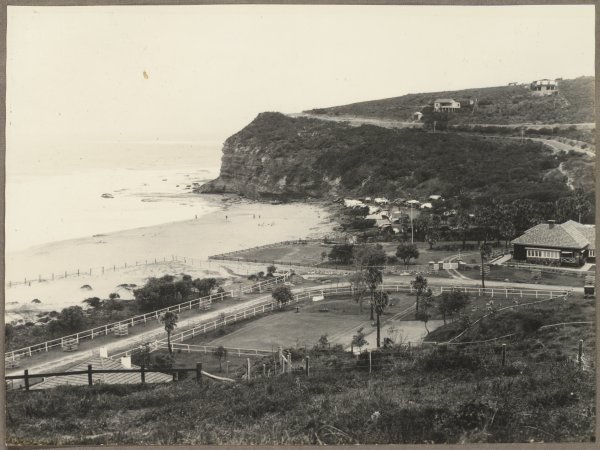 BILGOLA. A MAGNIFICENT SEASIDE RESIDENCE SURROUNDED BY BEAUTIFUL GROUNDS WITH PRIVATE SURFING BEACH. BILGOLA HOUSE the home of the late Mrs. H. Maclurcan Lee is now offered for sale with Instructions from the Executors at a price considerably below its original cost. It is a most attractively designed Residence faithfully built very well planned with all modern equipment and appliances. The accommodation consists of a spacious lounge room with open brick fire-place, five bedrooms, the principal bedrooms are connected with hot and cold water, maid's room, three bathrooms, two sleeping-out verandahs, a well fitted kitchen, pantry, ample cupboard space, hot water service, electric light private supply of soft water connected, and now city water Is also available.
BILGOLA. A MAGNIFICENT SEASIDE RESIDENCE SURROUNDED BY BEAUTIFUL GROUNDS WITH PRIVATE SURFING BEACH. BILGOLA HOUSE the home of the late Mrs. H. Maclurcan Lee is now offered for sale with Instructions from the Executors at a price considerably below its original cost. It is a most attractively designed Residence faithfully built very well planned with all modern equipment and appliances. The accommodation consists of a spacious lounge room with open brick fire-place, five bedrooms, the principal bedrooms are connected with hot and cold water, maid's room, three bathrooms, two sleeping-out verandahs, a well fitted kitchen, pantry, ample cupboard space, hot water service, electric light private supply of soft water connected, and now city water Is also available.
Right: Bilgola circa 1928 - 1930, courtesy National Library of Australia, Picture an24768552-v. Tents can be seen where the clubhouse now stands.
THE GROUNDS, which have an extensive frontage of about 303 frontage to Bilgola Avenue with a glorious outlook. They are very imposing and are an important feature of this property, being arranged in gardens, lawns, shrubs, rockeries, large aviaries, a shady palm plantation with its own golden beach in front. “Bilgola House” is undoubtedly in the picturesqueness of its outstanding its surroundings. Inspection by arrangement with Sole selling Agents RICHARD STANTON A. SONS PTY LTD, J.T. STAPLETON PTY LTD Stanton House 133 Pitt St Sydney Or over week end enquire at LOCAL OFFICE AVALON ph y9155. Advertising. (1938, January 1). The Sydney Morning Herald(NSW : 1842 - 1954), p. 20. Retrieved from http://nla.gov.au/nla.news-article17426157
SYDNEY, Mon— In agony with a broken leg, gardener Johann Peterson (63), of Bilgola, lay for more than seven hours on Bilgola beach (near Avalon) during the night. He had fallen from a 6ft. retaining wall last night. When his shouts for help were not heard he tried to clamber over the wall but fell back. Found at 5.30 a.m. today he was taken to hospital in a serious condition. All-Night Ordeal When Man, 63, Breaks Leg. (1948, March 8).The Daily News (Perth, WA : 1882 - 1950), p. 1 Edition: HOME EDITION. Retrieved fromhttp://nla.gov.au/nla.news-article79671249
ANOTHER ATTACK
SYDNEY, Thursday: Another attack on a woman was reported this afternoon, the victim being Mrs Austin, of Bilgola beach near Avalon. Police were told that Mrs Austin, returned by bus from a shopping expedition and when she entered her house she found a youth inside;.
She challenged the youth, who grabbed her. The woman gamely fought back, biting him on the ribs. She succeeded; in pulling out a draw from a cupboard and struck him across his mouth, freeing herself. She then raced into the street with her baby daughter. In rushing out she tripped and sprained her ankle, but managed to reach the road; where a passing motorist took her to the police and later to a doctor for treatment. ANOTHER ATTACK. (1946, October 25). Tweed Daily(Murwillumbah, NSW : 1914 - 1949), p. 4. Retrieved fromhttp://nla.gov.au/nla.news-article193124404
Bilgola becomes 'Bilgola Beach':
GEOGRAPHICAL NAMES ACT 1966
Notice to Discontinue a Geographical Name PURSUANT to the provisions of section 14 of the Geographical Names Act 1966, the Geographical Names Board hereby notifies that it has this day DISCONTINUED the geographical name of Bilgola within the Pittwater Local Government Area. Bilgola has been replaced by Bilgola Beach and Bilgola Plateau. K. RICHARDS, Acting Secretary Geographical Names Board, PO Box 143, Bathurst NSW 2795 - NSW Government Gazette 71. 2012-07-06. p. 3287.
The storm that almost washed Bilgola's residents away:
The Warringah –Shire Council made an emergency allocation of $20,000 today to save the Bilgola beachfront from further damage by huge seas. The president of Bilgola Beach Preservation Committee, Mr. Frank Wilson, said today that Bilgola Beach had disappeared altogether and seven homes were in danger of being washed into the sea. Ship splits in two as storms continue. (1974, June 12). The Canberra Times (ACT : 1926 - 1995), p. 3. Retrieved from http://nla.gov.au/nla.news-article110782971
AFTERMATH OF A DISASTROUS WEEKEND - Pictures
ABOVE: Before the gale-force tempest hit Sydney, this twisted pile of brick, wood veneer, and electricity wiring was No. 17, The Serpentine, Bilgola. On the beach-sidewalls warnings like "Trespassers will be vigorously prosecuted" had been scrawled in black paint. BELOW: Bird's-eye view of beach homes perched at the edge of the still irritable ocean at Bilgola beach. Even the makeshift seawall looks vulnerable in the path of the incoming tide. High on the cliff above the beach is the wreck of the house pictured above.
These pictures were taken last week as the skies were slowly clearing after the savage weekend of near-cyclonic wind and rain. All the N.S.W. coast was affected, especially the central area. In Sydney alone, damage is estimated at $50 million. Hardest hit were the city beaches, especially along the northern fringe.
LEFT: On Patonga Beach, Central Coast, $13,000 worth of fishing boat was wrecked and washed in to the shore.
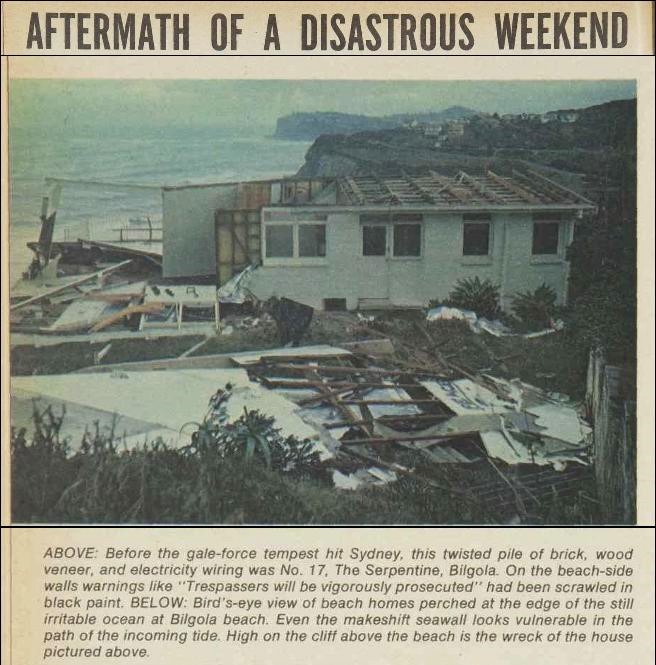
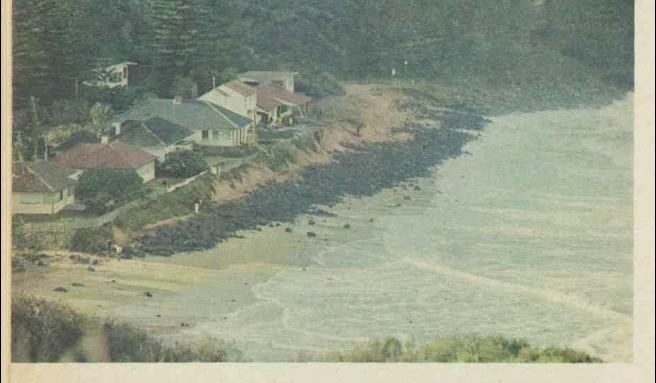
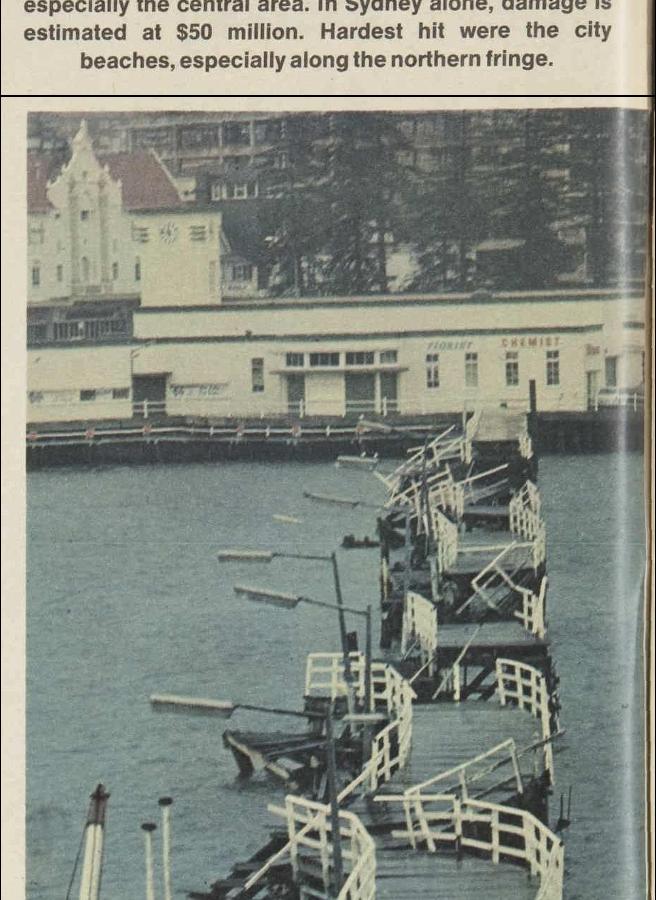
ABOVE: Warning notices about diving or spear-fishing or even riding bicycles cling haphazardly to Manly's storm-twisted promenade. During the height of the storm, the mesh wiring that made the pool shark-proof was torn apart, leaving the pool open to any grey nurse who chooses to drop in. At Manly alone damage is estimated at $50 million.
ABOVE: Splinters of pleasure craft and other pieces of wood drift dejectedly beside the Manly pier. At the devastated Harbour pool on the other side of the pier, members of the Maritime Services Board had worked from 6 a.m. to clean up the debris.
Pictures by Keith Barlow and Neville Waller. BELOW: Foam washed up by heavy seas at Wamberal, on the Central Coast, looks like smouldering smoke. AFTERMATH OF A DISASTROUS WEEKEND. (1974, June 12).The Australian Women's Weekly (1933 - 1982), p. 8. Retrieved from http://nla.gov.au/nla.news-article44557918
Pittwater Reserves, The Green Ways: Bilgola Beach - The Cabbage Tree Gardens and Camping Grounds- threads collected and collated by A J Guesdon, 2015.
Previous History Pages:
Marie Byles Lucy Gullett Kookoomgiligai Frank Hurley Archpriest JJ Therry Sir Patrick Gordon Taylor Bowen Bungaree W. Bradley 1788 Journal Midholme Loggan Rock Cabin La Corniche La Corniche II Lion Island Bungan Beach Botham Beach Scarred Trees Castles in the Sand Dame Nellie Melba lunches at Bilgola Spring, 1914 First to Fly in Australia at North Narrabeen Mona Vale Golf Club's Annual Balls Governor Phillip camps on Resolute Beach Ruth Bedford Jean Curlewis Mollie Horseman Charlotte Boutin May Moore Neville W Cayley Leon Houreux Frederick Wymark Sir Adrian Curlewis Bilgola Heron Cove Mullet Creek Shark Point Woodley's Cottage A Tent at The Basin Collin's Retreat-Bay View House-Scott's Hotel Bilgola Cottage and House The First Pittwater Regatta Women Cricketers Picnic Filmed In Pittwater Governor Phillip's Barrenjoey Cairn Waradiel Season The Church at Church Point Governor Phillipâs Exploration of Broken Bay, 2 â 9 March 1788 Petroglyths: Aboriginal Rock Art on the Northern Beaches Avalon Headland Landmarks Steamers Part I Pittwater Aquatic Club Part I Woody Point Yacht Club Royal Motor Yacht Club Part I Dorothea Mackellar Elaine Haxton Neva Carr Glynn Margaret Mulvey Jean Mary Daly Walter Oswald Watt Wilfrid Kingsford Smith John William Cherry George Scotty Allan McCarrs Creek Narrabeen Creek Careel Creek Currawong Beach Creek Bushrangers at Pittwater Smuggling at Broken Bay An Illicit Still at McCarr's Creek The Murder of David Foley Mona Vale Outrages Avalon Camping Ground Bayview Koala Sanctuary Ingleside Powder Works Palm Beach Golf Course Avalon Sailing Club Mona Vale Surf Life Saving Club Palm Beach SLSC Part I - The Sheds Warriewood SLSC Whale Beach SLSC Flagstaff Hill Mount Loftus Pill Hill Sheep Station Hill S.S. Florrie S.S. Phoenix and General Gordon Paddlewheeler MV Reliance The Elvina Florida House Careel House Ocean House and Billabong Melrose-The Green Frog The Small Yacht Cruising Club of Pittwater Canoe and I Go With The Mosquito Fleet - 1896 Pittwater Regattas Part I - Dates and Flagships to 1950 Shark Incidents In Pittwater The Kalori Church Point Wharf Bayview Wharf Newport Wharf Palm Beach Jetty - Gow's Wharf Max Watt Sir Francis Anderson Mark Foy John Roche Albert Verrills Broken Bay Customs Station At Barrenjoey Broken Bay Water Police Broken Bay Marine Rescue - Volunteer Coastal Patrol Pittwater Fire-Boats Prospector Powder Hulk at Towler's Bay Naval Visits to Pittwater 1788-1952 Pittwater's Torpedo Wharf and Range Naval Sea Cadets in Pittwater S.S. Charlotte Fenwick S.S. Erringhi P.S. Namoi S.Y. Ena I, II and III Barrenjoey Headland - The Lessees Barrenjoey Lighthouse - The Construction Barrenjoey Broken Bay Shipwrecks Up To 1900 Barrenjoey Light Keepers Douglas Adrian Ross Newport SLSC 1909 - 1938 Part I Overview North Narrabeen SLSC - The Formative Years Bilgola SLSC - the First 10 years North Palm Beach SLSC A History of Pittwater Parts 1 and 4 Pittwater Regattas - 1907 and 1908 Pittwater Regattas - 1921 - The Year that Opened and Closed with a Regatta on Pittwater Pittwater Regatta Banishes Depression - 1933 The 1937 Pittwater Regatta - A Fashionable Affair Careel Bay Jetty-Wharf-Boatshed Gow-Gonsalves Boatshed -Snapperman Beach Camping at Narrabeen - A Trickle then a Flood Pittwater's Parallel Estuary - The Cowan 'Creek' RMYC Broken Bay Boathouse and Boatshed Barrenjoey Boat House The Bona - Classic Wooden Racing Yacht Mona Vale Hospital Golden Jubilee - A Few Insights on 50 Years as a Community Hospital Far West Children's Health Scheme - the Formation Years The First Scotland Island Cup, Trophy and Race and the Gentleman who loved Elvina Bay Royal Motor Yacht Club Broken Bay NSW - Cruiser Division History - A History of the oldest division in the Royal Motor Yacht Club Royal Motor Yacht Club Broken Bay Early Motor Boats and Yachts, their Builders and Ocean Races to Broken Bay, the Hawkesbury and Pittwater The Mail Route to Pittwater and Beyond The Wild Coachmen of Pittwater - A Long and Sometimes Bumpy Ride on Tracks Instead of Roads The Fearless Men of Palm Beach SLSC's Surf Boats First Crews - A Tale of Viking Ships, Butcher Boats and Robert Gow's Tom Thumb 'Canoe' Furlough House Narrabeen - Restful Sea Breezes For Children and Their Mothers From Telegraphs to Telephones - For All Ships at Sea and Those On Land Mona Vale Training Grounds - From Lancers on Horses to Lasses on Transport Courses Fred Verrills; Builder of Bridges and Roads within Australia during WWII, Builder of Palm Beach Afterwards Communications with Pittwater Ferries To Pittwater A History of Pittwater - Part 4: West Head Fortress Pittwater's Lone Rangers - 120 Years of Ku-Ring-Gai Chase and the Men of Flowers Inspired by Eccleston Du Faur Early Pittwater Launches and Ferries Runs Avalon Beach SLSC - The First Clubhouse Avalon Beach SLSC The Second and Third Clubhouses From Beneath the Floorboards at Hyde Park Barracks Bungaree Was Flamboyant Andrew Thompson - 'Long Harry' Albert Thomas Black John Collins of Avalon Narrabeen Prawning Times - A Seasonal Tide of Returnings Oystering in the Pittwater Estuary - Oyster Kings and Pearl Kings and When Not to Harvest Oysters Yabbying In Warriewood Creeks Eeling in Warriewood's Creeks (Includes A Short History of community involvement in favour of environmental issues/campaigns in and around Narrabeen Lagoon - 1974 to present by David James OAM) Eunice Minnie Stelzer - Pittwater Matriarchs Maria Louisa Therry - Pittwater Matriarchs Katherine Mary Roche - Pittwater Matriarchs Sarah A. Biddy Lewis and Martha Catherine Bens Pittwater Matriarchs Pittwater's New Cycle Track of 1901 Manly to Newport The Rock Lily Hotel Barrenjoey House The Pasadena Jonah's St Michael's Arch The First Royal Visitor to Australia: the Incident at Clontarf March 12th, 1868 Pittwater: Lovely Arm of the Hawkesbury By NOEL GRIFFITHS - includes RMYC Wharf and Clareville Wharf of 1938 + An Insight into Public Relations in Australia George Mulhall First Champion of Australia in Rowing - First Light-Keeper at Barranjuey Headland Captain Francis Hixson - Superintendent of Pilots, Lights, and Harbours and Father of the Naval Brigade The Marquise of Scotland Island The First Boat Builders of Pittwater I: the Short Life and Long Voyages of Scotland Island Schooner the Geordy Boat Builders of Pittwater II: from cargo schooners and coasters to sailing skiffs and motorised launches The Currawong: Classic Yacht The Riddles of The Spit and Bayview/Church Point: sailors, boat makers, road pavers and winning rowers VP Day Commemorative Service 2015 – at Avalon Beach RSL Cenotaph: 70th Anniversary Captain T. Watson and his Captain Cook Statues: A Tribute to Kindness Pittwater Reserves: The Green Ways; Hordern or Wiltshire Parks to McKay Reserve – From Beach to Estuary Pittwater Reserves, The Green Ways: Clareville Wharf and Taylor's Point Jetty